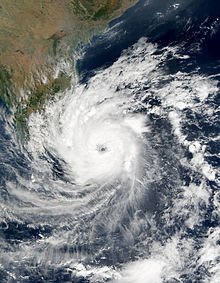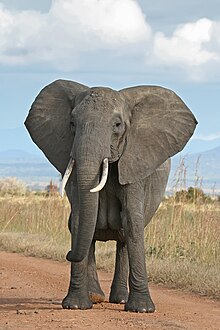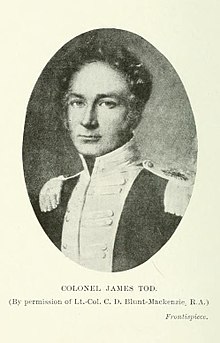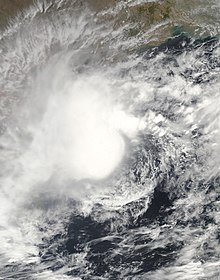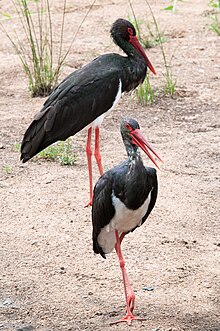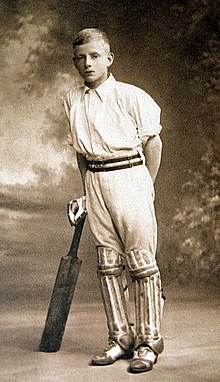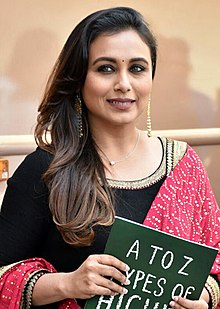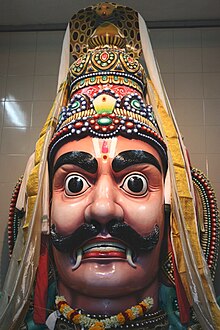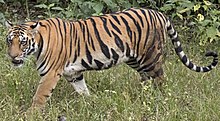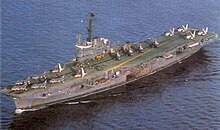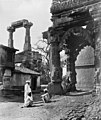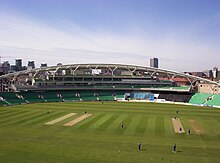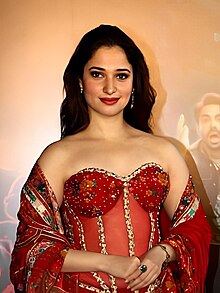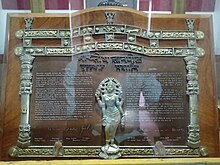Portal:India
Portal maintenance status: (June 2018)
|
Introduction


India, officially the Republic of India, is a country in South Asia. It is the seventh-largest country by area; the most populous country from June 2023 onwards; and since its independence in 1947, the world's most populous democracy. Bounded by the Indian Ocean on the south, the Arabian Sea on the southwest, and the Bay of Bengal on the southeast, it shares land borders with Pakistan to the west; China, Nepal, and Bhutan to the north; and Bangladesh and Myanmar to the east. In the Indian Ocean, India is near Sri Lanka and the Maldives; its Andaman and Nicobar Islands share a maritime border with Thailand, Myanmar, and Indonesia. (Full article...)
 Featured article – show another
Featured article – show another
-
Image 1Taare Zameen Par (lit. 'Stars on Earth'), also known as Like Stars on Earth in English, is a 2007 Indian Hindi-language drama film produced and directed by Aamir Khan. It stars Khan himself, with Darsheel Safary, Tanay Chheda, Vipin Sharma and Tisca Chopra. It explores the life and imagination of Ishaan (Safary), an artistically gifted 8-year-old boy whose poor academic performance leads his parents to send him to a boarding school, where a new art teacher Nikumbh (Khan) suspects that he is dyslexic and helps him to overcome his reading disorder. The film focuses on raising awareness about autism and psychiatric disability in children.
Creative director and writer Amole Gupte developed the idea with his wife Deepa Bhatia, who was the film's editor. Shankar–Ehsaan–Loy composed the score, and Prasoon Joshi wrote the lyrics for many of the songs. Principal photography took place in Mumbai, and in Panchgani's New Era High School, where some of the school's students participated in the filming. (Full article...) -
Image 2
Freida Selena Pinto (born 18 October 1984) is an Indian actress who has appeared mainly in American and British films. Born and raised in Mumbai, Maharashtra, she resolved at a young age to become an actress. As a student at St. Xavier's College, Mumbai she took part in amateur plays. After graduation, she briefly worked as a model and then as a television presenter.
Pinto rose to prominence with her film debut in the drama Slumdog Millionaire (2008), winning a SAG Award and earning a nomination for the BAFTA Award for Best Supporting Actress. She earned critical acclaim for her roles in Miral (2010), Trishna (2011), and Desert Dancer (2014). She also saw commercial success with the science fiction film Rise of the Planet of the Apes (2011), and the epic fantasy action film Immortals (2011). Pinto's other notable roles include You Will Meet a Tall Dark Stranger (2010), Love Sonia (2018), Hillbilly Elegy (2020), and Mr. Malcolm's List (2022). She also starred in the Showtime miniseries Guerrilla (2017), and had a recurring role in the Hulu series The Path (2018). (Full article...) -
Image 3Osbert Guy Stanhope Crawford CBE FBA FSA (28 October 1886 – 28 November 1957) was a British archaeologist who specialised in the archaeology of prehistoric Britain and Sudan. A keen proponent of aerial archaeology, he spent most of his career as the archaeological officer of the Ordnance Survey (OS) and also wrote a range of books on archaeological subjects.
Born in Bombay, British India, to a wealthy middle-class Scottish family, Crawford moved to England as an infant and was raised by his aunts in London and Hampshire. He studied geography at Keble College, Oxford, and worked briefly in that field before devoting himself professionally to archaeology. Employed by the philanthropist Henry Wellcome, Crawford oversaw the excavation of Abu Geili in Sudan before returning to England shortly before the First World War. During the conflict he served in both the London Scottish Regiment and the Royal Flying Corps, where he was involved in ground and aerial reconnaissance along the Western Front. After an injury forced a period of convalescence in England, he returned to the Western Front, where he was captured by the German Army in 1918 and held as a prisoner of war until the end of the conflict. (Full article...) -
Image 4
Brigadier-General Robert Montagu Poore, CIE, DSO, DL, JP (20 March 1866 – 14 July 1938) was an Anglo-Irish cricketer and British Army officer who, while serving in South Africa in 1896, played in three Test matches for the South African cricket team. He featured most prominently in first-class cricket playing county cricket in England for Hampshire between 1898 and 1906, where he gained a reputation as a batsman, having notable success in 1899 when he was the highest first-class run-scorer in England. Alongside playing for Hampshire, Poore also played first-class cricket in India for the Europeans in the Bombay Presidency Matches. An all-round sportsman, he was also a capable swordsman, and polo, tennis, racquets, and squash player, in addition to being a skilled marksman. Poore had success in the Royal Naval and Military Tournaments, being adjudged the best man-at-arms on four occasions.
Poore began his military service in the Volunteer Force with the 3rd (Royal Wiltshire Militia) Battalion of the Wiltshire Regiment in 1883, before gaining a regular commission in the British Army in 1886. From there, he transferred to the 7th Hussars in the same year and shortly after served in British India, where he was aide-de-camp to the Governor of Bombay. Poore served in the Second Matabele War in Southern Africa and later in the Second Boer War from 1899 to 1902, during which he was seconded to the Mounted Military Police and served as provost marshal at Army Headquarters Pretoria. In this role, he played an important part in investigating and recording the war–crimes trial and execution of Breaker Morant and Peter Handcock. Decorated with the Distinguished Service Order during the war, Poore later returned to the Hussars and served in the First World War between 1914 and 1918, commanding the Jhansi Brigade of the British Indian Army from 1915, for which he was made a Companion of the Order of the Indian Empire in 1918. He retired from active military service in 1921. In later life, he was a deputy lieutenant for Dorset. (Full article...) -
Image 5Loev (pronounced love) is a 2015 Indian romantic drama film written and directed by Sudhanshu Saria. It stars Dhruv Ganesh and Shiv Panditt as two friends who set off to the Western Ghats for a weekend trip and focuses on their complex emotional and sexual relationship. It was Ganesh's final film, as he died from tuberculosis before its release. Loev also features Siddharth Menon and Rishabh Chaddha in supporting roles. The film's title is a deliberate misspelling of the word "love".
Saria wrote Loev's script while he was working on the draft of the unreleased film I Am Here and drew heavily from his personal experiences. It was eventually picked up for production by Arfi Lamba and Katherine Suckale despite Saria's own doubts on its viability. Principal photography took place at Mahabaleshwar, in the Western Ghats in peninsular India, and at Mumbai. The film was shot in the summer of 2014 over the course of sixteen days by the cinematographer Sherri Kauk in 2K resolution. It relied on crowdfunding and cost-cutting measures; its budget was relatively low at US$1 million. (Full article...) -
Image 6
The 2000 Sri Lanka cyclone (IMD designation: BOB 06 JTWC designation: 04B) was the strongest tropical cyclone to strike Sri Lanka since 1978. The fourth tropical storm and the second severe cyclonic storm of the 2000 North Indian Ocean cyclone season, it developed from an area of disturbed weather on December 25, 2000. It moved westward, and quickly strengthened under favorable conditions to reach top wind speeds of 75 mph (121 km/h). The cyclone hit eastern Sri Lanka at peak strength, then weakened slightly while crossing the island before making landfall over southern India on December 28. The storm degenerated into a remnant low later that day, before merging with another trough on the next day.
The storm was the first cyclone over Sri Lanka with winds of at least hurricane strength since a cyclone of 1978 hit the island in the 1978 season, as well as the first tropical storm to hit the island since 1992. The storm was also the first December tropical cyclone of hurricane intensity in the Bay of Bengal since 1996. It produced heavy rainfall and strong winds, damaging or destroying tens of thousands of houses and leaving up to 500,000 homeless. At least nine people died as a result of the cyclone. (Full article...) -
Image 7A female African bush elephant in Mikumi National Park, Tanzania
Elephants are the largest living land animals. Three living species are currently recognised: the African bush elephant (Loxodonta africana), the African forest elephant (L. cyclotis), and the Asian elephant (Elephas maximus). They are the only surviving members of the family Elephantidae and the order Proboscidea; extinct relatives include mammoths and mastodons. Distinctive features of elephants include a long proboscis called a trunk, tusks, large ear flaps, pillar-like legs, and tough but sensitive grey skin. The trunk is prehensile, bringing food and water to the mouth and grasping objects. Tusks, which are derived from the incisor teeth, serve both as weapons and as tools for moving objects and digging. The large ear flaps assist in maintaining a constant body temperature as well as in communication. African elephants have larger ears and concave backs, whereas Asian elephants have smaller ears and convex or level backs.
Elephants are scattered throughout sub-Saharan Africa, South Asia, and Southeast Asia and are found in different habitats, including savannahs, forests, deserts, and marshes. They are herbivorous, and they stay near water when it is accessible. They are considered to be keystone species, due to their impact on their environments. Elephants have a fission–fusion society, in which multiple family groups come together to socialise. Females (cows) tend to live in family groups, which can consist of one female with her calves or several related females with offspring. The leader of a female group, usually the oldest cow, is known as the matriarch. (Full article...) -
Image 8Lage Raho Munna Bhai (pronounced [ləˈɡeː rəˈɦoː mʊnːaːˈbʱaːi] ⓘ; translation: Keep Going, Munna Bro) is a 2006 Indian Hindi-language satirical comedy drama film written, edited and directed by Rajkumar Hirani, who also co-wrote the screenplay with Abhijat Joshi, and produced by Vidhu Vinod Chopra under the banner Vinod Chopra Films. A sequel to Munna Bhai M.B.B.S. (2003), the film is the second installment of the Munna Bhai series. Sanjay Dutt and Arshad Warsi reprised their roles as the titular Munna Bhai and Circuit, respectively. New additions to the cast include Vidya Balan, Dilip Prabhavalkar and Dia Mirza, while several actors from the original, notably Jimmy Sheirgill and Boman Irani, appear in new roles.
In this film, the eponymous lead character, a don in the Mumbai underworld, begins to see visions of Mahatma Gandhi. Through his interactions with Gandhi, he begins to practice what he refers to as "Gandhigiri" (a neologism for "Gandhism") to help ordinary people solve their problems. (Full article...) -
Image 9
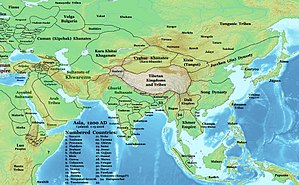
Territory of the Hoysalas and their neighbouring kingdoms in Western India, the Seuna Yadavas and Silharas in c. 1200[image reference needed]
Hoysala literature is the large body of literature in the Kannada and Sanskrit languages produced by the Hoysala Empire (1025–1343) in what is now southern India. The empire was established by Nripa Kama II, came into political prominence during the rule of King Vishnuvardhana (1108–1152), and declined gradually after its defeat by the Khalji dynasty invaders in 1311.
Kannada literature during this period consisted of writings relating to the socio-religious developments of the Jain and Veerashaiva faiths, and to a lesser extent that of the Vaishnava faith. The earliest well-known brahmin writers in Kannada were from the Hoysala court. While most of the courtly textual production was in Kannada, an important corpus of monastic Vaishnava literature relating to Dvaita (dualistic) philosophy was written by the renowned philosopher Madhvacharya in Sanskrit. (Full article...) -
Image 10Kal Ho Naa Ho (transl. Tomorrow may never come, pronounced [kəl ɦoː naː ɦoː]), also abbreviated as KHNH, is a 2003 Indian Hindi-language romantic comedy drama film directed by Nikhil Advani in his directorial debut with a story written by Karan Johar with dialogue by Niranjan Iyengar, and produced by Yash Johar. The film stars Shah Rukh Khan, Saif Ali Khan, and Preity Zinta, with Jaya Bachchan, Sushma Seth, Reema Lagoo, Lillete Dubey, and Delnaaz Irani in supporting roles. In the film, Naina Catherine Kapur (Zinta) and Aman Mathur (Shah Rukh Khan) fall in love, but a secret prevents him from reciprocating his feelings and results in a plan to set Naina up with her best friend, Rohit Patel (Saif Ali Khan).
Collaborating with Johar, Shankar–Ehsaan–Loy composed the soundtrack and score. Anil Mehta, Manish Malhotra, and Sharmishta Roy were the cinematographer, costume designer and art director, respectively. Principal photography took place in Toronto, New York City, and Mumbai from January to October 2003. The soundtrack was released on 27 September 2003 to positive reviews; the title song, "It's The Time To Disco", "Kuch To Hua Hai", and "Pretty Woman" were particularly well-received. (Full article...) -
Image 11
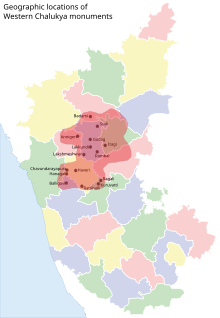
Core area of Western Chalukya architectural activity in modern Karnataka state, India
Western Chalukya architecture (Kannada: ಪಶ್ಚಿಮ ಚಾಲುಕ್ಯ ವಾಸ್ತುಶಿಲ್ಪ), also known as Kalyani Chalukya or Later Chalukya architecture and broadly classified under the Vesara Style, is the distinctive style of ornamented architecture that evolved during the rule of the Western Chalukya Empire in the Tungabhadra region of modern central Karnataka, India, during the 11th and 12th centuries. Western Chalukyan political influence was at its peak in the Deccan Plateau during this period. The centre of cultural and temple-building activity lay in the Tungabhadra region, where large medieval workshops built numerous monuments. These monuments, regional variants of pre-existing dravida (South Indian) temples, form a climax to the wider regional temple architecture tradition called Vesara or Karnata dravida. Temples of all sizes built by the Chalukyan architects during this era remain today as examples of the architectural style.
Most notable of the many buildings dating from this period are the Mahadeva Temple at Itagi in the Koppal district, the Kasivisvesvara Temple at Lakkundi in the Gadag district, the Mallikarjuna Temple at Kuruvatti in the Bellary district and the Kallesvara Temple at Bagali in the Davangere district. Other monuments notable for their craftsmanship include the Kaitabheshvara Temple in Kubatur and Kedareshvara Temple in Balligavi, both in the Shimoga district, the Siddhesvara Temple at Haveri in the Haveri district, the Amrtesvara Temple at Annigeri in the Dharwad district, the Sarasvati Temple in Gadag, and the Dodda Basappa Temple at Dambal, both in the Gadag district. (Full article...) -
Image 12
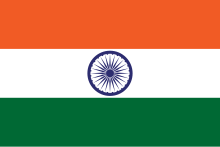
India, officially the Republic of India, is a country in South Asia. It is the seventh-largest country by area; the most populous country from June 2023 onwards; and since its independence in 1947, the world's most populous democracy. Bounded by the Indian Ocean on the south, the Arabian Sea on the southwest, and the Bay of Bengal on the southeast, it shares land borders with Pakistan to the west; China, Nepal, and Bhutan to the north; and Bangladesh and Myanmar to the east. In the Indian Ocean, India is near Sri Lanka and the Maldives; its Andaman and Nicobar Islands share a maritime border with Thailand, Myanmar, and Indonesia.
Modern humans arrived on the Indian subcontinent from Africa no later than 55,000 years ago. Their long occupation, predominantly in isolation as hunter-gatherers, has made the region highly diverse, second only to Africa in human genetic diversity. Settled life emerged on the subcontinent in the western margins of the Indus river basin 9,000 years ago, evolving gradually into the Indus Valley Civilisation of the third millennium BCE. By 1200 BCE, an archaic form of Sanskrit, an Indo-European language, had diffused into India from the northwest. Its hymns recorded the dawning of Hinduism in India. India's pre-existing Dravidian languages were supplanted in the northern regions. By 400 BCE, caste had emerged within Hinduism, and Buddhism and Jainism had arisen, proclaiming social orders unlinked to heredity. Early political consolidations gave rise to the loose-knit Maurya and Gupta Empires. Widespread creativity suffused this era, but the status of women declined, and untouchability became an organized belief. In South India, the Middle kingdoms exported Dravidian language scripts and religious cultures to the kingdoms of Southeast Asia. (Full article...) -
Image 13
The Indian roller (Coracias benghalensis) is a bird of the family Coraciidae. It is 30–34 cm (12–13 in) long with a wingspan of 65–74 cm (26–29 in) and weighs 166–176 g (5.9–6.2 oz). The face and throat are pinkish, the head and back are brown, with blue on the rump and contrasting light and dark blue on the wings and tail. The bright blue markings on the wing are prominent in flight. The sexes are similar in appearance. Two subspecies are recognised.
The Indian roller occurs widely from West Asia to the Indian subcontinent. Often found perched on roadside trees and wires, it is common in open grassland and scrub forest habitats, and has adapted well to human-modified landscapes. It mainly feeds on insects, especially beetles. The species is best known for the aerobatic displays of males during the breeding season. Adult males and females form pair bonds and raise the young together. The female lays 3–5 eggs in a cavity or crevice, which is lined with a thin mat of straw or feathers. The roller is the state bird of three Indian states. It is listed as a species of least concern on the IUCN Red List. (Full article...) -
Image 14The frontispiece of the 1920 edition of Tod's Annals and Antiquities of Rajast'han
Lieutenant-Colonel James Tod (20 March 1782 – 18 November 1835) was an officer of the British East India Company and an Oriental scholar. He combined his official role and his amateur interests to create a series of works about the history and geography of India, and in particular the area then known as Rajputana that corresponds to the present day state of Rajasthan, and which Tod referred to as Rajast'han.
Tod was born in London and educated in Scotland. He joined the East India Company as a military officer and travelled to India in 1799 as a cadet in the Bengal Army. He rose quickly in rank, eventually becoming captain of an escort for an envoy in a Sindian royal court. After the Third Anglo-Maratha War, during which Tod was involved in the intelligence department, he was appointed Political Agent for some areas of Rajputana. His task was to help unify the region under the control of the East India Company. During this period Tod conducted most of the research that he would later publish. Tod was initially successful in his official role, but his methods were questioned by other members of the East India Company. Over time, his work was restricted and his areas of oversight were significantly curtailed. In 1823, owing to declining health and reputation, Tod resigned his post as Political Agent and returned to England. (Full article...) -
Image 15
The 2003 Sri Lanka cyclone was a moderately powerful tropical cyclone that produced the worst flooding in Sri Lanka in 56 years. The first storm of the 2003 North Indian Ocean cyclone season, it developed over the Bay of Bengal on May 10. Favorable environmental conditions allowed the system to intensify steadily while moving northwestward. The storm reached peak maximum sustained winds of 140 km/h (85 mph) on May 13, making it a very severe cyclonic storm according to the India Meteorological Department (IMD), which is the official Regional Specialized Meteorological Center for the basin. The cyclone drifted north over the central Bay of Bengal, gradually weakening due to heightened wind shear. Turning eastward, the storm deteriorated to a deep depression on May 16 before it curved northeastward and re-intensified into a cyclonic storm. It came ashore in western Myanmar and dissipated over land the following day.
In the wake of prolonged precipitation during the first half of May, the cyclone produced torrential rains across southwest Sri Lanka while stationary in the central Bay of Bengal. The storm drew extensive moisture that coalesced in the mountainous portion of the island. A station at Ratnapura recorded 366.1 mm (14.41 in) of rainfall in 18 hours on May 17, including 99.8 mm (3.93 in) in one hour. In southwestern Sri Lanka, the rainfall caused flooding and landslides that destroyed 24,750 homes and damaged 32,426 others, displacing about 800,000 people. Overall damage totaled about $135 million (2003 USD), and there were 260 deaths. The cyclone also produced some rainfall in the Andaman and Nicobar Islands of India and along the country's eastern coast. The storm funneled moisture away from the mainland, which possibly contributed to a heat wave that killed 1,900 people, and dropped heavy rainfall in Myanmar. (Full article...) -
Image 16
The black stork (Ciconia nigra) is a large bird in the stork family Ciconiidae. It was first described by Carl Linnaeus in the 10th edition of his Systema Naturae. Measuring on average 95 to 100 cm (37 to 39 in) from beak tip to end of tail with a 145-to-155 cm (57-to-61 in) wingspan, the adult black stork has mainly black plumage, with white underparts, long red legs and a long pointed red beak. A widespread but uncommon species, it breeds in scattered locations across Europe (predominantly in Portugal and Spain, and central and eastern parts), and east across the Palearctic to the Pacific Ocean. It is a long-distance migrant, with European populations wintering in tropical Sub-Saharan Africa, and Asian populations in the Indian subcontinent. When migrating between Europe and Africa, it avoids crossing broad expanses of the Mediterranean Sea and detours via the Levant in the east, the Strait of Sicily in the center, or the Strait of Gibraltar in the west. An isolated non-migratory population lives in Southern Africa.
Unlike the closely related white stork, the black stork is a shy and wary species. It is seen singly or in pairs, usually in marshy areas, rivers or inland waters. It feeds on amphibians, small fish and insects, generally wading slowly in shallow water stalking its prey. Breeding pairs usually build nests in large forest trees—most commonly deciduous but also coniferous—which can be seen from long distances, as well as on large boulders, or under overhanging ledges in mountainous areas. The female lays two to five greyish-white eggs, which become soiled over time in the nest. Incubation takes 32 to 38 days, with both sexes sharing duties, and fledging takes 60 to 71 days. (Full article...) -
Image 17The political history of medieval Karnataka spans the 4th to the 16th centuries in Karnataka region of India. The medieval era spans several periods of time from the earliest native kingdoms and imperialism; the successful domination of the Gangetic plains in northern India and rivalry with the empires of Tamilakam over the Vengi region; and the domination of the southern Deccan and consolidation against Muslim invasion. The origins of the rise of the Karnataka region as an independent power date back to the fourth-century birth of the Kadamba Dynasty of Banavasi which was the earliest of the native rulers to conduct administration in the native language of Kannada in addition to the official Sanskrit.
In the southern regions of Karnataka, the Western Gangas of Talakad were contemporaries of the Kadambas. The Kadambas and Gangas were followed by the imperial dynasties of the Badami Chalukya Empire, the Rashtrakuta Empire, the Western Chalukya Empire, the Hoysala Empire and the Vijayanagara Empire, all patronising the ancient Indic religions while showing tolerance to the new cultures arriving from the west of the subcontinent. The Muslim invasion of the Deccan resulted in the breaking away of the feudatory Sultanates in the 14th century. The rule of the Bahamani Sultanate of Bidar and the Bijapur Sultanate from the northern Deccan region caused a mingling of the ancient Hindu traditions with the nascent Islamic culture in the region. The hereditary ruling families and clans ably served the large empires and upheld the local culture and traditions. The fall of the Vijayanagara Empire in 1565 brought about a slow disintegration of Kannada-speaking regions into minor kingdoms that struggled to maintain autonomy in an age dominated by foreigners until unification and independence in 1947. (Full article...) -
Image 18Padukone at the 2018 Cannes Film Festival
Deepika Padukone (pronounced [d̪iːpɪkaː pəɖʊkoːɳeː]; born 5 January 1986) is an Indian actress who works predominantly in Hindi films. She is India's highest-paid actress, as of 2023, and her accolades include three Filmfare Awards. Time named her one of the 100 most influential people in the world in 2018 and awarded her the Time100 Impact Award in 2022.
Padukone, the daughter of the badminton player Prakash Padukone, was born in Copenhagen and raised in Bangalore. As a teenager, she played badminton in national level championships but left her career in the sport to become a fashion model. She soon received offers for film roles and made her acting debut in 2006 as the title character of the Kannada film Aishwarya. Padukone then played a dual role opposite Shah Rukh Khan in her first Bollywood release, the romance Om Shanti Om (2007), which won her the Filmfare Award for Best Female Debut. Padukone received praise for her starring role in the romance Love Aaj Kal (2009), but this was followed by a brief setback. (Full article...) -
Image 19
Arthur Edward Jeune Collins (18 August 1885 – 11 November 1914) was an English cricketer and soldier. He held, for 116 years, the record of highest score in cricket: as a 13-year-old schoolboy, he scored 628 not out over four afternoons in June 1899. Collins's record-making innings drew a large crowd and increasing media interest; spectators at the Old Cliftonian match being played nearby were drawn away to watch the junior school house cricket match in which Collins was playing. Despite this achievement, Collins never played first-class cricket. Collins's 628 not out stood as the record score until January 2016 when an Indian boy, Pranav Dhanawade, scored 1009 in a single innings.
Collins joined the British Army in 1902 and studied at the Royal Military Academy, Woolwich, before becoming an officer in the Royal Engineers. He served in France during the First World War, where he was killed in action in 1914 during the First Battle of Ypres. Collins had been mentioned in despatches and also represented the Royal Military Academy at cricket and rugby union. (Full article...) -
Image 20Sir Robert Eric Mortimer Wheeler CH CIE MC TD FRS FBA FSA (10 September 1890 – 22 July 1976) was a British archaeologist and officer in the British Army. Over the course of his career, he served as Director of both the National Museum of Wales and London Museum, Director-General of the Archaeological Survey of India, and the founder and Honorary Director of the Institute of Archaeology in London, in addition to writing twenty-four books on archaeological subjects.
Born in Glasgow to a middle-class family, Wheeler was raised largely in Yorkshire before moving to London in his teenage years. After studying classics at University College London (UCL), he began working professionally in archaeology, specialising in the Romano-British period. During World War I he volunteered for service in the Royal Artillery, being stationed on the Western Front, where he rose to the rank of major and was awarded the Military Cross. Returning to Britain, he obtained his doctorate from UCL before taking on a position at the National Museum of Wales, first as Keeper of Archaeology and then as Director, during which time he oversaw excavation at the Roman forts of Segontium, Y Gaer, and Isca Augusta with the aid of his first wife, Tessa Wheeler. Influenced by the archaeologist Augustus Pitt Rivers, Wheeler argued that excavation and the recording of stratigraphic context required an increasingly scientific and methodical approach, developing the "Wheeler method". In 1926, he was appointed Keeper of the London Museum; there, he oversaw a reorganisation of the collection, successfully lobbied for increased funding, and began lecturing at UCL. (Full article...) -
Image 21
Preity G. Zinta (pronounced [ˈpriːt̪i ˈzɪɳʈa]; born 31 January 1975) is an Indian actress and entrepreneur primarily known for her work in Hindi films. After graduating with degrees in English honours and criminal psychology, Zinta made her acting debut in Dil Se.. in 1998, followed by a role in Soldier in the same year. These performances earned her the Filmfare Award for Best Female Debut, and she was later recognised for her role as a teenage single mother in Kya Kehna (2000). She established a career as a leading Hindi film actress of the decade with a variety of character types. Her roles, often deemed culturally defiant, along with her unconventional screen persona won her recognition and several accolades.
Following critically appreciated roles in Chori Chori Chupke Chupke (2001), Dil Chahta Hai (2001), Dil Hai Tumhaara (2002), and Armaan (2003), Zinta received the Filmfare Award for Best Actress for her performance in Kal Ho Naa Ho (2003). She starred in two consecutive annual top-grossing films in India, Koi... Mil Gaya (2003) and Veer-Zaara (2004), and was noted for her portrayal of independent, modern Indian women in Salaam Namaste (2005) and Kabhi Alvida Naa Kehna (2006), top-grossing productions in domestic and overseas markets. For her first international role in the Canadian drama Heaven on Earth (2008) she was awarded the Silver Hugo Award for Best Actress and nominated for the Genie Award for Best Actress. She followed this with a hiatus from acting work for several years, with intermittent appearances such as in her self-produced comeback film, Ishkq in Paris (2013), which failed to leave a mark. (Full article...) -
Image 22Mukerji promoting Hichki in 2018
Rani Mukerji (pronounced [raːni mʊkʰərdʒi]; born 21 March 1978) is an Indian actress who works in Hindi films. Noted for her versatility, she is the recipient of multiple accolades, including eight Filmfare Awards. Mukerji has featured in listings of the leading and highest-paid actresses of the 2000s.
Born into the Mukherjee-Samarth family, Mukerji dabbled with acting as a teenager by starring in her father Ram Mukherjee's Bengali-language film Biyer Phool and in the social drama Raja Ki Aayegi Baaraat (both 1996). Mukerji had her first commercial success with the action film Ghulam and breakthrough with the romance Kuch Kuch Hota Hai (both 1998). Following a brief setback, the year 2002 marked a turning point for her when she was cast by Yash Raj Films as the star of the drama Saathiya. (Full article...) -
Image 23Aravan worshipped at Sri Mariamman Temple, Singapore. A cobra hood is sheltering Aravan's head.
Iravan also known as Iravat and Iravant, is a minor character from the Hindu epic Mahabharata. The son of Pandava prince Arjuna (one of the main heroes of the Mahabharata) and the Naga princess Ulupi, Iravan is the central deity of the cult of Kuttantavar (Kuttandavar) which is also the name commonly given to him in that tradition—and plays a major role in the sect of Draupadi. Both these sects are of Tamil origin, from a region of the country where he is worshipped as a village deity and is known as Aravan. He is also a patron god of well-known transgender communities called Alis (also Aravani in Tamil, and Hijra throughout South Asia).
The Mahabharata portrays Iravan as dying a heroic death on the 8th day of the 18-day Kurukshetra War (Mahabharata war), the epic's main subject. However, the South Indian traditions have a supplementary practice of honouring Aravan's self-sacrifice to the goddess Kali to ensure her favour and the victory of the Pandavas in the war. The Kuttantavar tradition focuses on one of the three boons granted to Aravan by the god Krishna in honour of this self-sacrifice. Aravan requested that he be married before his death. Krishna satisfied this boon in his female form, Mohini. In Koovagam, Tamil Nadu, this incident is re-enacted in an 18-day festival, first by a ceremonial marriage of Aravan to Alis (hijra) and male villagers (who have taken vows to Aravan) and then by their widowhood after ritual re-enactment of Aravan's sacrifice. (Full article...) -
Image 24A Bengal tigress in Kanha Tiger Reserve, India
The tiger (Panthera tigris) is a large cat and a member of the genus Panthera native to Asia. It has a powerful, muscular body with a large head and paws, a long tail and orange fur with black, mostly vertical stripes. It is traditionally classified into nine recent subspecies, though some recognise only two subspecies, mainland Asian tigers and the island tigers of the Sunda Islands.
Throughout the tiger's range, it inhabits mainly forests, from coniferous and temperate broadleaf and mixed forests in the Russian Far East and Northeast China to tropical and subtropical moist broadleaf forests on the Indian subcontinent and Southeast Asia. The tiger is an apex predator and preys mainly on ungulates, which it takes by ambush. It lives a mostly solitary life and occupies home ranges, defending these from individuals of the same sex. The range of a male tiger overlaps with that of multiple females with whom he mates. Females give birth to usually two or three cubs that stay with their mother for about two years. When becoming independent, they leave their mother's home range and establish their own. (Full article...) -
Image 25
INS Vikrant (from Sanskrit vikrānta, "courageous") was a Majestic-class aircraft carrier of the Indian Navy. The ship was laid down as HMS Hercules for the British Royal Navy during World War II, but was put on hold when the war ended. India purchased the incomplete carrier in 1957, and construction was completed in 1961. Vikrant was commissioned as the first aircraft carrier of the Indian Navy and played a key role in enforcing the naval blockade of East Pakistan during the Indo-Pakistani War of 1971.
In its later years, the ship underwent major refits to embark modern aircraft, before being decommissioned in January 1997. She was preserved as a museum ship in Naval Docks, Mumbai until 2012. In January 2014, the ship was sold through an online auction and scrapped in November 2014 after final clearance from the Supreme Court. (Full article...)
Selected pictures
-
Image 1A statue of the Hindu god Shiva as Nataraja, the Lord of Dance. In this form, Shiva performs his divine dance to destroy a weary universe and make preparations for the god Brahma to start the process of creation. A Telugu and Tamil concept, Shiva was first depicted as Nataraja in the famous Chola bronzes and sculptures of Chidambaram. The form is present in most Shiva temples in South India, and is the main deity in Chidambaram Temple, the foremost Shaivist temple.
-
Image 2Photograph: Yann; edit: Jim CarterA view of the Taj Mahal from the south, featuring the Charbagh garden. The mausoleum complex also includes subsidiary tombs, waterworks infrastructure, the small town of Taj Ganji, and a "moonlight garden". Its origins and architecture have been extensively documented, covering both the circumstances of its commission and the cultural and historical influence of the Islamic Mughal Empire in India.
-
Image 3Photograph credit: Bourne & Shepherd; retouched by Yann ForgetThe Rudra Mahalaya Temple is an ancient temple complex at Siddhpur in the Patan district of Gujarat, India. The temple was completed in 1140 by Jayasimha Siddharaja, but in 1296, Alauddin Khalji sent an army under Ulugh Khan and Nusrat Khan, who dismantled the structure. In 1414 or 1415, the temple was further destroyed and the western part was converted into a congregational mosque by Muslim ruler Ahmad Shah I of the Muzaffarid dynasty. Apart from the mosque, the surviving fragments consist of two porches, a torana (ornamental gateway) and a few pillars.
-
Image 4Photograph: Muhammad Mahdi KarimMysore Palace, the official residence and seat of the Wodeyars — the rulers of the Kingdom of Mysore. Located in southern India, the kingdom is traditionally believed to have been founded in 1399 as a vassal state to the Vijayanagara Empire before becoming independent in the 16th century.
-
Image 5Photograph credit: Rucha Karkarey; edited by John HarrisonThe round ribbontail ray (Taeniura meyeni) is a species of stingray in the family Dasyatidae, found throughout the nearshore waters of the tropical Indo-Pacific region. Reaching 1.8 m (6 ft) across, this large ray is characterized by a thick, rounded pectoral fin disc covered by small tubercles on top, and a relatively short tail bearing a single venomous spine. The ray is well-camouflaged when lying on the seabed; it is largely nocturnal, and preys on molluscs, crustaceans and bony fish. Mature females bear litters of up to seven pups, which are fed during gestation on "uterine milk", a product secreted by the walls of the oviduct. This round ribbontail ray was photographed in Lakshadweep, India.
-
Image 6Photograph credit: Augustus BinuK. T. Thomas (born 30 January 1937) is a former judge of the Supreme Court of India, known for his strong opinions on Indian socio-political matters. He was selected as a district and sessions judge in 1977, and became a judge of the Kerala High Court in 1985. A decade later, he was appointed a judge of the Supreme Court, on which he served until retiring in 2002. He was awarded the Padma Bhushan by the Indian government in 2007 for services in the field of social affairs.
-
Image 7Photograph: Muhammad Mahdi KarimBangles on display in Bangalore, India. These rigid bracelets are usually made from metal, wood, or plastic and are traditionally worn by women in India, Nepal, Pakistan, and Bangladesh. In India, it is a common tradition to see a new bride wearing glass bangles at her wedding and the honeymoon will end when the last bangle breaks.
-
Image 8Photograph credit: Augustus BinuPomegranate juice is a beverage made from the fruit of the pomegranate. It is used in cooking both as a fresh juice and as a concentrated syrup. The fruit originated in the region extending from Iran to northern India and has been cultivated since ancient times. The fruit has a hard outer husk and a spongy mesocarp in which the seeds in their fleshy seedcoats are embedded. Pomegranate juice can be sweet or sour, but most fruits are moderate in taste. The juice has long been a popular drink in Europe and the Middle East, and is now widely distributed in the United States and Canada.
-
Image 9Photograph: Arthur Chapman; edit: Papa Lima Whiskey and Ryan KaldariBrahmaea wallichii, also known as the owl moth, is a moth from the family Brahmaeidae. With a wingspan of about 90–160 mm (3.5–6.3 in), it is one of the largest species of Brahmin moth. This nocturnal species is found in India, Bhutan, Myanmar, China, Taiwan and Japan.
-
Image 10Photograph credit: Prathyush ThomasMacrotyloma uniflorum, commonly known as horse gram, is a legume native to tropical southern Asia. The plant grows from a rhizome, sending up annual shoots to a height of 60 cm (24 in). The flowers are cream, yellow or pale green and are followed by short pods. The seeds, pictured here, have been consumed in India for at least 4,000 years and are used both for animal feed and human consumption, including Ayurvedic cuisine. In other tropical countries in southeastern Asia, and in northern Australia, the plant is grown mainly as a fodder crop and for use as green manure. It is a drought-tolerant plant, largely cultivated in areas with low rainfall.
-
Image 11Photograph credit: Charles J. SharpThe nilgai or blue bull (Boselaphus tragocamelus) is the largest Asian antelope and is endemic to the Indian subcontinent. The sole member of the genus Boselaphus, the species was described and given its binomial name by German zoologist Peter Simon Pallas in 1766. The nilgai stands 1–1.5 metres (3.3–4.9 ft) at the shoulder; males weigh 109–288 kilograms (240–635 lb), and the lighter females 100–213 kilograms (220–470 lb). A sturdy thin-legged antelope, the nilgai is characterised by a sloping back, a deep neck with a white patch on the throat, a short crest of hair along the neck terminating in a tuft, and white facial spots. A column of pendant coarse hair hangs from the dewlap ridge below the white patch. Sexual dimorphism is prominent – while females and juveniles are orange to tawny, adult males have a bluish-grey coat. Only males possess horns, which are 15–24 centimetres (5.9–9.4 in) in length.
This picture shows a male nilgai in a potato field at Jamtra, in the Indian state of Madhya Pradesh. -
Image 12A potter at work in Jaura, Madhya Pradesh, India. Pottery, defined by ASTM International as "all fired ceramic wares that contain clay when formed, except technical, structural, and refractory products", originated during the Neolithic period.
-
Image 13Photograph credit: Charles James SharpThe Indian rhinoceros (Rhinoceros unicornis) is a species of rhinoceros that once ranged across the entire northern part of the Indian subcontinent. As a result of habitat destruction and climatic changes, its range was gradually reduced such that, by the 19th century, it survived only in southern Nepal, northern Uttar Pradesh, northern Bihar, northern West Bengal, and in the Brahmaputra Valley in Assam. The species's range has since shrunk further, and its habitat is surrounded by human-dominated landscapes, so that in many areas, it occurs in cultivated areas, pastures, and secondary forests. It is currently listed as a vulnerable species on the IUCN Red List. This adult male Indian rhinoceros was photographed on the banks of the Gandaki River in Nepal.
-
Image 14Photograph credit: Charles James SharpThe pied bush chat (Saxicola caprata) is a small passerine bird widely distributed in Asia. The males are black with white shoulder and vent patches, while the females are predominantly brownish. This species is insectivorous, and like other chats hunts from a prominent low perch. This female pied bush chat was photographed in Pench National Park, India.
-
Image 15Photograph: JkadavoorCupha erymanthis is a species of brush-footed butterfly found in forested areas of tropical South and Southeast Asia which may feed on liquids from carrion. This specimen was photographed in Kadavoor, Kerala, India.
 Featured list – show another
Featured list – show another
-
Image 1
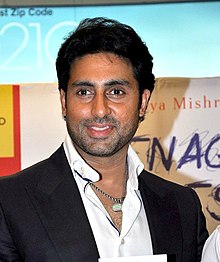
Bachchan in 2013
Abhishek Bachchan is an Indian actor and film producer known for his work in Hindi films. He made his acting debut opposite Kareena Kapoor in J. P. Dutta's war drama Refugee (2000), where his portrayal of the titular unnamed refugee earned a nomination for the Filmfare Best Male Debut Award. However, the film was a box office debacle alike his subsequent films, including Bas Itna Sa Khwaab Hai (2001), and Shararat (2002). His career prospects improved in 2004, when he played a gangster in Mani Ratnam's political drama Yuva and a police officer in Sanjay Gadhvi's action thriller Dhoom. The former won him his first Filmfare Award for Best Supporting Actor, and the latter became one of the highest-grossing films of the year and his first commercial success.
In 2005, Bachchan teamed up with his father twice in Ram Gopal Varma's thriller Sarkar and the crime comedy Bunty Aur Babli. The latter was the second highest-grossing film of the year, and his performance in Sarkar earned him a second Filmfare Award for Best Supporting Actor. That same year, he appeared in the Bengali film Antarmahal (2005). 2006 proved to be key for Bachchan, as he received his third consecutive Filmfare Best Supporting Actor Award for his performance in Karan Johar's musical romance Kabhi Alvida Naa Kehna (2006), and reprised his role in the action sequel Dhoom 2 (2006), which became the highest grossing Bollywood film to that point. Bachchan next starred alongside Aishwarya Rai in Ratnam's critically and commercially successful drama Guru (2007), a biopic inspired by the life of businessman Dhirubhai Ambani. His title role in the film was positively received. (Full article...) -
Image 2
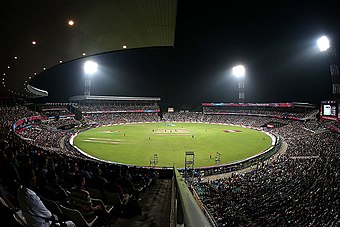
Eden Gardens during a day/night match
The Eden Gardens is a cricket ground in Kolkata, India. It is one of the main international cricket venues of India and often called the "Mecca of Indian cricket". It is the home of the Bengal cricket team and the Kolkata Knight Riders, as well as being a Test, One Day International (ODI) and Twenty20 International (T20I) venue. As of 2020, the Eden Gardens has hosted more than 40 Test matches, the first of which was in January 1934 when India played the touring England team. These include the first ever day/night Test match in India which was hosted between 22 and 24 November 2019, when India played the visiting Bangladesh team. The first ODI played at the ground was between India and Pakistan on 18 February 1987. As of 2020, 30 ODIs have been played at the ground.
The first Test century scored at the ground was in December 1948, by Everton Weekes of the West Indies. He scored 162 runs in the first innings. In the same match Syed Mushtaq Ali of India scored 106 in the fourth innings, thus becoming the first Indian to have scored a century at the Eden Gardens. To date, 77 Test centuries have been scored at the ground. VVS Laxman's 281, scored against Australia in March 2001, during the famous second test of Border-Gavaskar Trophy, is the highest individual Test score achieved at the ground. The highest individual Test score by an overseas player is 256, scored by Rohan Kanhai of the West Indies in December 1958. Mohammad Azharuddin and VVS Laxman have scored five Test centuries each, the highest number of Test centuries scored by an individual player at the ground. During the second Test of the India–South Africa Test series held in February 2010 at the ground, a total of seven centuries were scored between the two teams. This is the highest number of centuries scored in a single Test match at the ground. (Full article...) -
Image 3
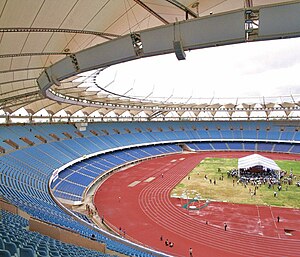
Jawaharlal Nehru Stadium as it appeared in July 2010, was the main venue for the 1982 Asiad.
The 1982 Asian Games (also known as the IX Asiad)[a] was a multi-sport event held in Delhi, India, from 12 November to 4 December 1982. A total of 3,411 athletes from 33 National Olympic Committees (NOCs) participated in these games, competing in 147 events in 21 sports and 22 disciplines. The number of participating countries was the greatest in Asian Games history. Sport events of handball, equestrian, rowing and golf were included for the first time; while fencing and bowling were excluded. This medal table ranks the participating NOCs by the number of gold medals won by their athletes.
Athletes from 23 participating NOCs won at least one medal; athletes from 16 of these NOCs secured at least one gold. Athletes from China won 61 gold medals, the most of any nation at these Asiad, and led the gold-medal count for the first time in their Asiad history. Japan had won the greatest number of medals in previous editions of the Games. China first competed at the Asian Games in 1974, in Tehran, where it finished third. Athletes from both China and Japan won the most total medals with 153. China has secured the top medal spot in every Asiad since 1982. South Korea finished third in total medals. North Korea finished fifth in total medals, and fourth in the gold-medal count. Host nation India finished the games with 57 medals overall (13 gold, 19 silver and 25 bronze, its best performance since 1951), in fifth spot in terms of total gold medals. (Full article...) -
Image 4
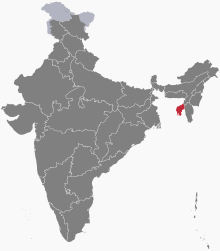
Location of Tripura (highlighted in red) within India
The Tripura Legislative Assembly is the unicameral legislature of the state of Tripura, in Northeast India. The seat of the legislative assembly is at Agartala, the capital of the state. The assembly sits for a term of five years, unless it is dissolved earlier. Tripura is the third-smallest state in India, covering 10,491 km2 (4,051 sq mi); and the seventh-least populous state with a population of 3.67 million. The Tripura Legislative Assembly has existed since 1963, when it had 30 constituencies. As of the 2023 elections, it has 60 constituencies.
Since the independence of India, the Scheduled Castes (SC) and Scheduled Tribes (ST) have been given Reservation status, guaranteeing political representation, and the Constitution lays down the general principles of positive discrimination for SCs and STs. The 2011 census of India stated that indigenous people constitute 32% of the state's total population. The Scheduled Tribes have been granted a reservation of 20 seats in the assembly, while 10 constituencies are reserved for candidates of the Scheduled Castes. (Full article...) -
Image 5

Ashwin has taken a pair of five-wicket hauls in a match on four occasions.
In cricket, a five-wicket haul (also known as a "fifer") refers to a bowler taking five or more wickets in a single innings. This is regarded as a notable achievement, and as of October 2024[update] only 54 bowlers have taken 15 or more five-wicket hauls at international level in their cricketing careers. Ravichandran Ashwin – a right-arm off break bowler – is a Test, One Day International (ODI) and Twenty20 International (T20I) cricketer who represents the India national cricket team. In a 2016 interview, former Sri Lankan cricketer Muttiah Muralitharan described Ashwin as the "best current Test spinner". As of September 2024[update], Ashwin has taken 37 five-wicket hauls in international cricket; he ranks joint-fourth in the all-time list, and joint-first among his countrymen.
Ashwin made his Test debut in November 2011 against the West Indies. He took nine wickets in the match, including a five-wicket haul in the second innings. India won the match and his performance earned him the man of the match honour. His career-best figures of seven wickets for 59 runs came against New Zealand in October 2016; in the process he also became the fifth bowler to take six five-wicket hauls against them. He has picked up ten or more wickets in a match on seven occasions. Ashwin made his ODI and T20I debuts in June 2010 against Sri Lanka and Zimbabwe, respectively, and is yet to take a five-wicket haul in both formats. His four wickets for 25 runs against the United Arab Emirates in the 2015 World Cup remain his best in ODIs, while his figures of four wickets for 8 runs against Sri Lanka are his best in T20Is. (Full article...) -
Image 6

Districts of West Bengal
The Himalayas lies in the north of West Bengal and the Bay of Bengal is at the south. Between them, the river Ganga flows eastwards and its main distributary, the Hooghly River, flows south to reach the Bay of Bengal. The Siliguri Corridor, which connects North-East India with rest of the India, lies in the North Bengal region of the state. Geographically, West Bengal is divided into a variety of regions—Darjeeling Himalayan hill region, Terai and Dooars region, North Bengal plains, Rarh region, Western plateau and high lands, coastal plains, Sundarbans and the Ganga Delta.
In 1947, when India gained independence, the state of West Bengal was formed, with 14 districts, as per partition plan of the then Bengal province of British India. The former princely state Koch Bihar joined as a district on 26 January 1950, and the former French enclave Chandannagore joined as part of the Hooghly district in 1954. The States Reorganisation Act of 1956 led to addition of Purulia district to the state and to enlargement of West Dinajpur district. Later, larger districts such as West Dinajpur, 24 Parganas and Midnapore were bifurcated. (Full article...) -
Image 7
Chandrasekhar's six wickets for 38 runs at the Kennington Oval was influential in setting up India's first ever series victory in England.
B. S. Chandrasekhar is a former international cricketer who represented the Indian cricket team between 1964 and 1979. In cricket, a five-wicket haul refers to a bowler taking five or more wickets in a single innings. This is regarded as a notable achievement, and as of October 2024[update], only 54 bowlers have taken 15 or more five-wicket hauls at international level in their cricketing careers. Chandrasekhar played as a leg spin bowler who formed a part of the Indian spin quartet. Described by West Indies cricketer Viv Richards as the "most difficult" bowler, Chandrasekhar took 16 five-wicket hauls during his international career. He developed an interest in the game when he was a child, watching the playing styles of Australian leg spinner Richie Benaud. Chandrasekhar was affected by polio at the age of five which weakened his right arm. He started as a left-arm bowler but gradually shifted to his withered right arm as it could offer more spin.
Chandrasekhar made his Test debut in 1964 against England at the Brabourne Stadium, claiming four wickets for 67 runs in the first innings. His first five-wicket haul came against West Indies two years later at the same venue. Chandrasekhar's bowling figures of six wickets for 38 runs in 1971 were instrumental in setting up India's first victory in England. It was noted as the Indian "Bowling Performance of the Century" by Wisden in 2002. His bowling performances in the previous English season led to him being named one of the five Wisden Cricketers of the Year in 1972. His career-best figures for an innings were eight wickets for 79 runs against England at the Feroz Shah Kotla Ground in December 1972. Chandrasekhar took a pair of five-wicket hauls for the only time in his career when he took 12 wickets for 104 runs against Australia at the Melbourne Cricket Ground; the performance was effective in ensuring India's first victory in Australia. In Tests, he was most successful against England taking eight fifers. (Full article...) -
Image 8
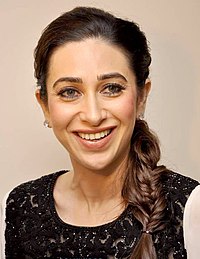
Kapoor at an event in 2013
Karisma Kapoor is an Indian actress widely known for her work in Hindi films. Kapoor made her acting debut at the age of seventeen with the romance Prem Qaidi in 1991, which was a box office hit. She then appeared in successful ventures, drama Sapne Sajan Ke (1992), and action drama Jigar (1992). Kapoor had her first commercial success in a leading role in romantic action drama Anari (1993), which was a moderate success and was one of the highest-grossing Hindi films of 1993. Between 1993–1996 she featured in several highly successful films, including the comedy drama Raja Babu (1994), action drama Suhaag (1994), action comedy Andaz (1994), the comedies Coolie No. 1 (1995), Saajan Chale Sasural (1996), and Hero No. 1 (1997), and the action thriller Jeet (1996). The success of these films marked a turning point in her career, and established Kapoor as one of the leading actresses in Hindi cinema.
Kapoor's career prospects improved in 1996 when Dharmesh Darshan cast her in his romantic drama Raja Hindustani. With worldwide earnings of ₹763.4 million (US$8.8 million), it emerged as the highest-grossing film of the year and the fourth highest-grossing film in India of the 1990s. The film earned her praise from critics, and Kapoor won her first Filmfare Award for Best Actress. The following year, she received widespread recognition as well as the National Film Award and Filmfare Award for Best Supporting Actress for portraying a headstrong dancer in Dil To Pagal Hai, a musical romantic drama produced by Yash Raj Films. Subsequently, she played leading roles in several blockbuster films, including the comedies Biwi No.1 (1999), the ensemble family drama Hum Saath-Saath Hain (1999), and the romantic comedy Dulhan Hum Le Jayenge (2000). Her acclaimed performance of a disillusioned sister of Hrithik Roshan's character in the crime drama Fiza (2000) which earned her a second Best Actress award at Filmfare. The following year, she portrayed actress Zubeida Begum in the biographical drama Zubeidaa (2001), won her a Filmfare Award for Best Actress (Critics). In 2002, she portrayed a troubled daughter-in-law in the revenge-seeking war drama Shakti: The Power. (Full article...) -
Image 9
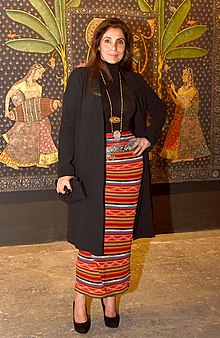
Kapadia at the Pichvai Exhibition in New Delhi, 2018
Dimple Kapadia is an Indian actress who predominantly appears in Hindi films. She was discovered by Raj Kapoor at age 14, who gave her the title role in his teen romance Bobby (1973), opposite his son Rishi Kapoor. The film became a massive commercial success and made her an overnight star. Her role as a Christian teenager from Goa established her as a youth fashion icon and won her the Filmfare Award for Best Actress. Kapadia retired from acting following her marriage to Indian actor Rajesh Khanna earlier in 1973, and returned to the film industry in 1984, after her separation from Khanna. The release of her comeback film, Saagar, was delayed, with Zakhmi Sher becoming the second film of her career. Released in 1985, Saagar earned her a second Best Actress award at Filmfare, and she went on to establish herself as one of the leading actresses of Hindi cinema in the 1980s and early 1990s. The early roles she played following her return included the Hitchcockian thriller Aitbaar (1985), for which she received positive reviews, and the commercially successful action films Arjun (1985) and Janbaaz (1986). During this period, she acted in several films in South India, which she admitted to having made for financial gain and dismissed their quality.
Many of Kapadia's early roles relied on her perceived beauty, and she would struggle to be taken seriously as an actress. She made a decision to accept more serious roles, and won acclaim for her role in the marital drama Kaash (1987). Financial success came with films like Insaniyat Ke Dushman (1987), Insaaf (1987), in which she played double roles; the controversial revenge saga Zakhmi Aurat (1988), in which she played an avenging rape victim; and Ram Lakhan (1989). She started the next decade by venturing into neorealist art films, known in India as parallel cinema, including Drishti (1990), Lekin... (1990), and Rudaali (1993). All these films won her critical praise, and her role as a professional mourner in the latter earned her a National Film Award for Best Actress and a Filmfare Critics Award for Best Actress. She further essayed character parts in Prahaar (1991), Angaar (1992), Gardish (1993), and Krantiveer (1994), which garnered her a fourth Filmfare Award, in the Best Supporting Actress category. (Full article...) -
Image 10
Tamannaah Bhatia is an Indian actress known for her work in Telugu, Tamil and Hindi cinema. She debuted as a leading lady in the Hindi film Chand Sa Roshan Chehra in 2005. That same year marked her Telugu debut with Sree, followed by her Tamil debut in Kedi the subsequent year. She experienced a breakthrough in her career with the success of Happy Days and Kalloori in 2007, portraying college students in both films. Her journey continued with box-office hits like Ayan, 100% Love, Siruthai, Tadakha, Oosaravelli, Racha and Veeram as well as setbacks such as Ananda Thandavam, Endukante Premanta, Himmatwala, Humshakals and Aagadu. Additionally, while she received critical acclaim and several accolades for her role in 100% Love, her performances in Himmatwala and Humshakals faced criticism.
In 2015, Bhatia received praised for her role in Baahubali: The Beginning, which earned over ₹600 crore. She was praised for her performances in Oopiri and Dharma Durai, and her double role in Devi was well received. However, Vasuvum Saravananum Onna Padichavanga, Bengal Tiger and Kaththi Sandai were less successful. In 2017, she reprised her role in Baahubali 2: The Conclusion, which grossed over ₹1700 crore worldwide, while Anbanavan Asaradhavan Adangadhavan was a box office failure. In 2018, Sketch received mixed reviews, but her performance was praised, while Naa Nuvve and Next Enti? were poorly received. In 2019, she starred in the blockbuster F2: Fun and Frustration and delivered notable performances in Kanne Kalaimaane, Devi 2, Khamoshi, Sye Raa Narasimha Reddy and Petromax. (Full article...) -
Image 11The 2022 recipient: Neena Gupta
The National Film Award for Best Actress in a Supporting Role (known as National Film Award for Best Supporting Actress prior to 69th NFA) is an honour presented annually at India's National Film Awards ceremony by the National Film Development Corporation of India (NFDC), an organisation set up by the Indian Ministry of Information and Broadcasting. Since 1984, the award is given by a national panel appointed annually by the NFDC to an actress for the best performance in a supporting role within Indian cinema. It is presented by the President of India at a ceremony held in New Delhi. Since the 70th National Film Awards, the name was changed to "Best Actress in a Supporting Role".
The winner is given a "Rajat Kamal" (Silver Lotus) certificate and a cash prize of ₹2,00,000. Including ties and repeat winners, the NFDC has presented a total of 41 Best Supporting Actress awards to 35 different actresses. Although Indian cinema produces films in more than 20 languages, the performances of films that have won awards are of ten languages: Hindi (19 awards), Malayalam (7 awards), Bengali (4 awards), Tamil (4 awards), English (2 awards), Meitei (1 award), Marathi (1 award), Urdu (1 award), Haryanvi (1 award), Odia (1 award). (Full article...) -
Image 12My Name Is Khan is a 2010 drama film directed by Karan Johar. The film features Shah Rukh Khan and Kajol in the lead roles with Jimmy Sheirgill, Zarina Wahab, Sonya Jehan, Vinay Pathak and Parvin Dabas playing supporting roles. Set in the United States, the film's story focuses on Rizwan Khan (Khan), a non-resident Indian with Asperger syndrome whose wife, Mandira (Kajol), has a child, Sameer, from a previous relationship. During the aftermath of the September 11 attacks, Sameer dies as a result of a racist assault by school bullies. Mandira blames Sameer's death on Rizwan due to his religion, and tells him not to come back until he can convince the President of the United States that he is not a terrorist. Rizwan takes Mandira's words literally and tries to meet the President so as to win her back. My Name Is Khan was co-produced by Johar's brother, Hiroo Yash Johar, and Khan's wife, Gauri Khan, under the Dharma Productions and Red Chillies Entertainment banners respectively. Shankar–Ehsaan–Loy composed the soundtrack while Niranjan Iyengar and Javed Akhtar wrote the lyrics for its songs. Ravi K. Chandran, Deepa Bhatia and Sharmishta Roy handled the cinematography, editing and production design respectively.
Produced on a budget of ₹850 million (about US$19 million in 2010), My Name Is Khan was released on 12 February 2010 and received positive reviews. It was commercially successful, grossing ₹2.048 billion (about US$45 million in 2010) worldwide. The film won 25 awards from 84 nominations; its direction, story, screenplay, performances of the cast members and music have received the most attention from award groups. (Full article...) -
Image 13
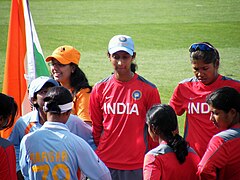
Members of the Indian cricket team before a Women's World Twenty20 game in Sydney, 2009
The India women's national cricket team represents India in international women's cricket. A full member of the International Cricket Council (ICC), the team is governed by the Board of Control for Cricket in India (BCCI). The India women's national cricket team first competed in 1976 when they played the West Indies in a six-match Test series at home. They recorded their first victory in the fourth match held at the Moin-ul-Haq Stadium, Patna; however, a loss in the sixth match led to the series being tied. India secured their first overseas victory in a one-off series against South Africa in 2002. As of October 2022[update], they have played 38 Test matches against five different opponents—Australia, England, South Africa, New Zealand and the West Indies. In terms of victories, they have been most successful against England and South Africa with two wins against each of them.
India played their first Women's One Day International cricket (WODI) match against England in the 1978 World Cup, which they hosted. They finished at the bottom of the table as they lost the remaining two games of the group stage. In the 1982 World Cup, they won their first ever WODI match when they beat the International XI by 79 runs at McLean Park, Napier. India's first overseas WODI series win came at the 1994–95 New Zealand Women's Centenary Tournament. They won the WODI series during their tour 1999 of England. They were the runner-up at the 2005 and the 2017 World Cup tournaments. As of October 2022[update], they have played 301 WODIs against twelve different opponents, and have the fourth highest number of victories (164) for any team in the format; They have recorded 81 wins and have been the fifth most successful team in the T20 format. Since their first Women's Twenty20 International (WT20I) against England in August 2006, India have played 151 matches. They have been most successful against Bangladesh with eleven wins against them. They were among the semi-finalists in the 2009 and 2010 ICC Women's World Twenty20 tournaments. (Full article...) -
Image 14Enthiran (transl. Robot) is a 2010 Indian Tamil-language science fiction film directed by S. Shankar and produced by Kalanithi Maran. Shankar wrote the screenplay and co-wrote the dialogues with Sujatha and Madhan Karky. The film stars Rajinikanth and Aishwarya Rai with Danny Denzongpa, Santhanam, and Karunas playing supporting roles. The musical score was composed by A. R. Rahman while the cinematography, visual effects, editing, and art direction were handled by R. Rathnavelu, V. Srinivas Mohan, Anthony, and Sabu Cyril respectively. The film's story revolves around a scientist's struggle to control his creation, an android robot whose software is upgraded to give it the ability to comprehend and generate human emotions. The plan backfires when the robot falls in love with the scientist's fiancée and is further manipulated by a rival scientist to bring destruction to all who stand in its way. The film was dubbed into Hindi as Robot.
Produced on an estimated budget of ₹1.32 billion, Enthiran was released on 1 October 2010 and yielded a revenue of ₹1.79 billion according to a report by the Sun TV Network. The film garnered awards and nominations in several categories, with particular praise for its cinematography, visual effects, art direction, costume design, and Rajinikanth's performance. The film has won 25 awards from 38 nominations. (Full article...) -
Image 15

Mahesh Babu (born 9 August 1975) is an Indian actor, producer, and media personality who works in Telugu cinema. He is one of the highest-paid actors in Indian cinema. Born on the 9th of August, 1975, he first appeared in the 1979 film Needa when he was four years old. He continued to perform as a child actor in several films, most of which featured his father Krishna.Following his role as the titular protagonist in Balachandrudu (1990) while still a child, his career went on hiatus so he could concentrate on his education until taking on his first lead role as an adult in the 1999 film Rajakumarudu, for which he won the Nandi Award for Best Male Debut. Afterwards, his career stagnated until successes like Murari (2001), Okkadu (2003) and Athadu (2005) brought him fame..Athadu is widely considered to be a modern classic of Telugu cinema. It holds the record of being the most telecasted Telugu film with over 1,000 times on television.. In 2006, he played a gangster in the Puri Jagannadh-directed action-thriller Pokiri. The film became the highest-grossing Telugu film of all time, and according to Vogue India, cemented Babu's reputation as a "superstar". In its lifetime, Pokiri grossed ₹66 crore and collected a distributor share of ₹42 crore at the global box office.
In the wake of the failures of Sainikudu (2006) and Athidhi (2007), Babu took a long-term break from cinema for personal reasons. His next project, the fantasy action film Khaleja, was released in 2010 after significant delays.. The film was listed in the Film Companion's "25 Greatest Telugu Films of the Decade.". In 2011, he starred in Dookudu, which became the first Telugu film to gross over 100 crores. Businessman (2012), his next film, was well received and became one of the year's highest grossing Telugu films at a time that was particularly harsh on other big-budget productions. The film collected a distributor share of ₹44.8 crore and grossed over ₹90 crore in its lifetime at the global box office. The following year, Babu co-starred alongside Venkatesh in the critically and commercially acclaimed drama film Seethamma Vakitlo Sirimalle Chettu, which was considered the first Telugu multi-starrer in decades. Seethamma Vakitlo Sirimalle Chettu netted ₹38.75 crore at the AP/Nizam box office during its run, earning a distributor share of ₹51 crore at the global box office and declared a commercial success. He then featured in Sukumar's 2014 psychological thriller film 1: Nenokkadine. Although Babu's performance as a schizophrenic rock star was lauded by critics, the film itself received mixed reviews and failed to recover its budget. The film earned a distributor share of about ₹28.9 crore, on a budget of ₹70 crore..The film received mixed-to-positive reviews from critics, praising Sukumar's direction, screenplay, writing, musical score, emotional weight, cinematography, action sequences and cast performances (especially Babu), however the complexity in screenplay and length received mixed reception. The film won three awards from eight nominations at the 4th South Indian International Movie Awards, and two awards at the 11th CineMAA Awards. The film is considered one of the "25 Greatest Telugu Films Of The Decade" by Film Companion.. Aagadu, his next release that year, suffered a similar fate, despite the film's opening gross being his highest at the time. Aagadu grossed ₹18.02 crore within its first two days. However, it underperformed at the box office, failing to recover its budget of ₹65 crore during its theatrical run. The film's failure was primarily attributed to its similarities with Dookudu and other successful Telugu films. (Full article...) -
Image 16

Kangana Ranaut's performance in Queen garnered her several awards and nominations including the National Film Award for Best Actress at the 62nd National Film Awards.
Queen is a 2013 Indian comedy-drama film directed by Vikas Bahl and produced by Anurag Kashyap and Vikramaditya Motwane. The film stars Kangana Ranaut in the lead role, and features Rajkummar Rao and Lisa Haydon in supporting roles. The film was edited by Abhijit Kokate and Kashyap, and the cinematography was provided by Bobby Singh. Amit Trivedi composed the musical score for the film. Queen tells the story of Rani, an under-confident woman, who embarks on her honeymoon alone after her fiancé calls off their wedding.
Made on a budget of ₹125 million (US$1.4 million), Queen was released on 7 March 2014, and grossed ₹970 million (US$11 million) worldwide. The film garnered awards and nominations in several categories, with particular praise for its direction, performance of Ranaut, cinematography, and editing. As of June 2015, the film has won 32 awards. (Full article...) -
Image 17Mani Ratnam is an Indian filmmaker who works predominantly in Tamil cinema. Regarded as one of the greatest Indian filmmakers, he is credited with redefining the "range and depth of Tamil cinema". As of 2019, he has directed 28 films, and produced over 15 under his production company Madras Talkies.
Mani Ratnam made his directorial debut, without formal training or education in filmmaking, with the Kannada film Pallavi Anu Pallavi (1983). The critically acclaimed film, which he also wrote, won him the Karnataka State Film Award for Best Screenplay. Then he entered Malayalam film industry with Unaroo, which was based on then prevailing trade union politics. His first Tamil film Pagal Nilavu (1985) was a commercial failure, but immediately followed Idaya Kovil (1985) found theatrical success. The following year, he made the romantic drama Mouna Ragam, which narrated the story of a young woman who is forced into an arranged marriage by her family. The critical and commercial success of the film established him as a leading filmmaker in Tamil cinema. His next release Nayakan, starring Kamal Haasan, was inspired by the life of the Bombay-based gangster Varadarajan Mudaliar. The film was submitted by India as its official entry for the 60th Academy Awards. Later in 2005, Nayakan was included in Time's "All-Time 100 Movies" list. Mani Ratnam followed this with the tragic romance Geethanjali (1989), which marked his Telugu cinema debut; the tragedy Anjali (1990), which narrated the story of an autistic child; and the crime drama Thalapathi (1991), loosely adapted from the Indian epic Mahabharata. In 1992, he made the romantic thriller Roja for Kavithalayaa Productions. The film was dubbed into many Indian languages, including Hindi, and its widespread success brought national recognition to Mani Ratnam. Three years later, he made Bombay (1995), which was based on the 1992–93 Bombay riots. Although controversial for its depiction of religious riots, the film met with wide critical acclaim and became commercially successful in India. (Full article...) -
Image 18
The Jnanpith Award is the oldest and the highest Indian literary award presented annually by the Bharatiya Jnanpith to an author for their "outstanding contribution towards literature". Instituted in 1961, the award is bestowed only on Indian writers writing in Indian languages included in the Eighth Schedule to the Constitution of India and English, with no posthumous conferral.
From 1965 till 1981, the award was given to the authors for their "most outstanding work" and consisted of a citation plaque, a cash prize and a bronze replica of Saraswati, the Hindu goddess of knowledge and wisdom. The first recipient of the award was the Malayalam writer G. Sankara Kurup who received the award in 1965 for his collection of poems, Odakkuzhal (The Bamboo Flute), published in 1950. The rules were revised in subsequent years to consider only works published during the preceding twenty years, excluding the year for which the award was to be given and the cash prize was increased to ₹1.5 lakh (equivalent to ₹31 lakh or US$35,000 in 2023) from 1981. (Full article...) -
Image 19
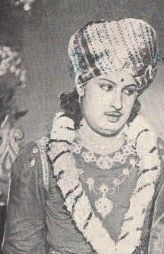
M. G. Ramachandran in Mohini (1948)
M. G. Ramachandran (17 January 1917 – 24 December 1987), popularly known by his initials "MGR", was an Indian actor, film director and film producer who had an extensive career primarily in Tamil language films. After starring in numerous commercially successful films from the 1950s to the early 1970s, he has continued to hold a matinée idol status in Tamil Nadu. Ramachandran made his debut in Ellis R. Dungan's 1936 film Sathi Leelavathi, where he played a police inspector. He followed it with a string of minor appearances and supporting roles in many films, notably Ashok Kumar (1941), where he played the general of emperor Ashoka's army, and as a captain in Dungan's Meera (1945).
Ramachandran's breakthrough came with his first lead role in A. S. A. Sami's swashbuckler film Rajakumari (1947) where he played a villager who marries a princess. Based on the Arabian Nights, Rajakumari was a commercially successful venture. He established himself as an action hero akin to Errol Flynn and Douglas Fairbanks in Tamil cinema with Manthiri Kumari (1950) and Marmayogi (1951). Both films had political undertones which earned Ramachandran a Robin Hood persona of being a champion for the downtrodden. His performance as the caring brother Rajendran who tries to keep his family together in En Thangai (1952) earned him critical acclaim. In 1953, he made his debut in Malayalam films opposite B. S. Saroja in Genova. Ramachandran continued to play roles which enabled him to adopt his ideas of fighting injustice meted out to the poor such as an outlaw in Malaikkallan (1954), and Nadodi Mannan (1958). In the latter, he featured in dual roles, as a king and a commoner, for the first time in his career. Both Malaikkallan and Nadodi Mannan were commercially successful, becoming the highest-grossing films of their respective release years. In addition to social dramas, Ramachandran received positive feedback and commercial success for swashbuckler films such as Alibabavum 40 Thirudargalum (1956), the first South Indian full-length colour film, Madurai Veeran (1956), Chakravarthi Thirumagal and Mahadevi (both released in 1957). (Full article...) -
Image 20

Haasan in 2014
Shruti Haasan is an Indian actress and singer who works in Telugu, Hindi and Tamil films. She started her career as a playback singer at the age of six in the 1992 Tamil film Thevar Magan. She had a brief role in her father, Kamal Haasan's Tamil-Hindi directorial Hey Ram (2000) as a child artist. Haasan's first major appearance was in the Hindi film Luck (2009), in which she played a dual role of a woman avenging her twin sister's death. She played the female lead in the films Anaganaga O Dheerudu and 7aum Arivu; both were released in 2011 and together earned her the Best Female Debut – South at the 59th Filmfare Awards South ceremony.
Haasan's subsequent releases Oh My Friend (2011) and 3 (2012) were commercially unsuccessful. The latter earned her a nomination for the Best Actress – Tamil at the 60th Filmfare Awards South ceremony. A turning point came in Haasan's career with Harish Shankar's commercially successful Telugu film Gabbar Singh (2012). The release was followed by a series of successful films such as Balupu (2013) and Yevadu (2014). She received her first Filmfare Award for Best Actress – Telugu for her performance in Race Gurram (2014). (Full article...) -
Image 21

The national president of the Bharatiya Janata Party is the chief executive authority of the BJP, and fills a number of roles, including chairing meetings of the National Executive of the party and appointing the presidents of party subsidiaries, such its youth wing and farmer's wing. Any candidate for the presidency needs to have been a member of the party for at least 15 years. The president is nominally elected by an electoral college composed of members drawn from the party's National and State councils, but in practice is a consensus choice of senior members of the party. The term of the president is three years long, and individuals may not serve more than two consecutive terms. The president usually does not also hold a post within a government, and party chiefs have resigned the position to assume posts in Cabinet.
After the party's foundation in 1980, Atal Bihari Vajpayee became its first president. He later became the prime minister of India, the only BJP president to serve in that position to date. In 1986, Lal Krishna Advani was sworn in as the party president and has been the longest serving president over three different periods. As of 2022, 11 people have served as the president of the BJP, including Rajnath Singh and Amit Shah who have also served two terms. J. P. Nadda is the most recent president, having been appointed in January 2020. (Full article...) -
Image 22

Padukone in 2019
Indian actress Deepika Padukone primarily appears in Hindi films. Her first screen appearance was in Himesh Reshammiya's music video "Naam Hai Tera" in 2005. Padukone made her film debut by playing the title role in the Kannada-language film Aishwarya (2006). Her first Hindi film release came the following year with Farah Khan's melodrama Om Shanti Om, in which she played dual roles opposite Shah Rukh Khan. She won the Filmfare Award for Best Female Debut for it. Her sole film role in 2008 was as one of Ranbir Kapoor's love interests in Bachna Ae Haseeno. Padukone's first film release of 2009, the kung fu comedy Chandni Chowk to China, proved to be a box office flop, but her next release, Imtiaz Ali's romance Love Aaj Kal, opposite Saif Ali Khan, was a success. Of Padukone's five film releases in 2010, only the comedy Housefull was financially profitable. The series of poorly received films continued with both her 2011 releases, Aarakshan and Desi Boyz.
The acclaimed role of an impulsive party-girl in Homi Adajania's Cocktail (2012) proved to be a breakthrough for Padukone. The year 2013 was key for Padukone when all four of her films were box office hits. Among these were two of the highest-grossing Indian films—the romantic comedies Yeh Jawaani Hai Deewani and Chennai Express. She also won the Filmfare Award for Best Actress for playing a character based on Juliet in Sanjay Leela Bhansali's tragic romance Goliyon Ki Raasleela Ram-Leela (2013). In 2014, Padukone appeared in the Tamil animation film Kochadaiiyaan and played a bar dancer in the top-grossing heist film Happy New Year. The following year, she played a headstrong daughter in Shoojit Sircar's comedy-drama Piku, which earned Padukone her second Best Actress award at Filmfare, and portrayed the warrior Mastani in Bhansali's top-grossing historical romance Bajirao Mastani. (Full article...) -
Image 23
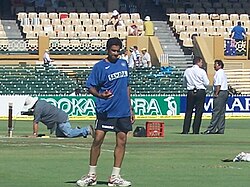
Anil Kumble, India's leading wicket-taker in Tests and ODIs
In cricket, a five-wicket haul (also known as a "five–for" or "fifer") refers to a bowler taking five or more wickets in a single innings. This is regarded as a notable achievement, as of October 2024[update] only 54 bowlers have taken 15 or more five-wicket hauls at an international level in their cricketing careers.
Anil Kumble is a former Test and One Day International (ODI) cricketer who represented India. He is a right-arm leg spin (legbreak googly) bowler. Kumble has taken 619 wickets in Test cricket and 337 wickets in ODI cricket. With 37 five-wicket hauls, Kumble has the highest number of Test and combined international five-wicket hauls among Indian cricketers and fourth highest among all players, after Muttiah Muralitharan, Richard Hadlee, and Shane Warne.
Kumble made his ODI debut against Sri Lanka and his Test debut against England, both in 1990. His first five-wicket haul was against South Africa at Johannesburg (November 1992) in the second Test of India's tour. He has claimed the most of his five-wicket hauls against Australia, ten of them, all in Test matches. His best performance was against Pakistan at the Feroz Shah Kotla in 1999; Kumble took all ten wickets during the second innings, just the second person to do so, after Jim Laker, and in the process ensured India of their first Test victory against Pakistan in twenty years. The feat also ranks as the second-best bowling figure in Test history. Twenty of Kumble's Test cricket five-wicket hauls have come in victory for India, while five have been in defeats. Kumble has also taken two five-wicket hauls in ODIs. His first ODI five-wicket haul was against the West Indies during the final of the 1993 Hero Cup at Eden Gardens, Calcutta when he took six wickets for twelve runs, a record for India in One Day Internationals. The performance ensured India's victory and Kumble was adjudged man of the match. His other ODI five-wicket haul was against New Zealand at the Basin Reserve in 1994. (Full article...) -
Image 24

Members of the Indian cricket team before a Women's Cricket World Cup game in Sydney
A One Day International (ODI) is an international cricket match between two teams, each having ODI status, as determined by the International Cricket Council. The women's variant of the game is similar to the men's version, with minor modifications to umpiring and pitch requirements. The first women's ODI was played in 1973, between England and Australia. The Indian women's team played their first ever ODI match in 1978, against England, after the Women's Cricket Association of India was formed. The Women's Cricket Association of India was merged with the Board of Control for Cricket in India in 2006 as part of the International Cricket Council's initiative to develop women's cricket.
Since the team was formed, 151 women have represented India in ODI cricket. This list includes all players who have played at least one ODI match and is arranged in the order of debut appearance. Where more than one player won their first cap in the same match, those players are listed alphabetically by last name at the time of debut. (Full article...) -
Image 25Zindagi Na Milegi Dobara (English: You Live Only Once) is a 2011 Indian coming-of-age film directed by Zoya Akhtar, who also co-wrote the film along with Reema Kagti. It is produced by Excel Entertainment. The film stars an ensemble cast of Hrithik Roshan, Abhay Deol and Farhan Akhtar, with Katrina Kaif and Kalki Koechlin in supporting roles. The musical score for the film was composed by the trio Shankar–Ehsaan–Loy. Its cinematography was provided by Carlos Catalan. The film narrates the story of three friends on a bachelor trip and how each of them discover themselves and overcome their problems and insecurities.
Made on a budget of ₹550 million (US$6.4 million), Zindagi Na Milegi Dobara was released on 5 July 2011 and grossed over ₹1.53 billion (US$18 million) worldwide. Rotten Tomatoes, a review aggregator, surveyed 7 reviews and judged 100 percent to be positive. The film garnered awards and nominations in several categories, with particular praise for its direction, screenplay, and the performances of its cast. As of 2015, the film has won 33 awards from 66 nominations. (Full article...)
 Good article – show another
Good article – show another
-
Image 1
Statue of Vishnu carrying the Kaumodaki in his lower left arm
Kaumodaki (Sanskrit: कौमोदकी, romanized: Kaumodakī, lit. 'captivator of the mind') is the gadā (mace) of the Hindu deity Vishnu. Vishnu is often depicted holding the Kaumodaki in one of his four hands; his other attributes are the chakra, the conch and the lotus. The gada is also found in the iconography of some of Vishnu's avatars.
The name, 'Kaumodak' first appears in the Hindu epic Mahabharata, where it is associated with Vishnu's avatar, Krishna. The gada is depicted in images of Vishnu since c. 200 BCE. While initially unadorned, the size and shape of Kaumodaki vary in depictions. More elaborate design features like flutes and segments were added in depictions of Vishnu's gada. (Full article...) -
Image 2The Param Vir Chakra (PVC) is India's highest military decoration, awarded for displaying distinguished acts of valour during wartime. Param Vir Chakra translates as the "Wheel of the Ultimate Brave", and the award is granted for "most conspicuous bravery in the presence of the enemy". As of January 2018[update], the medal has been awarded 21 times, of which 14 were posthumous and 16 arose from actions in Indo-Pakistani conflicts. Of the 21 awardees, 20 have been from the Indian Army and one has been from the Indian Air Force. Major Somnath Sharma was the first recipient. A number of state governments of India as well as ministries of the central government provide allowances and rewards to recipients of the PVC (or their family members in case of the recipient's death).
The history of present-day Indian gallantry awards can be traced back to the rule of the East India Company, when the first formal award was instituted by Lord William Bentinck in 1834 as the Order of Merit, later renamed the Indian Order of Merit in 1902. During the First World War, the British awards system was adopted and continued through the Second World War. Post-independence, new awards were instituted on 26 January 1950, with retroactive effect from 15 August 1947. The PVC is equivalent to the Victoria Cross in the United Kingdom and the Medal of Honor in the United States. (Full article...) -
Image 3
Amrita Rao (born 7 June) is an Indian actress who primarily works in Hindi films. Known for her "quintessential girl-next-door" portrayals, Rao is the recipient of an IIFA Award and two Stardust Awards, along with nominations for two Filmfare Awards.
Rao made her acting debut with Ab Ke Baras (2002), which earned her a nomination for Filmfare Award for Best Female Debut. Rao won the IIFA Award for Star Debut of the Year – Female for her portrayal of a college student in the romantic drama Ishq Vishk (2003), her first commercial success. She had further success in the masala action comedy film Main Hoon Na (2004), the romance drama movie Vivah (2006), the comedy Masti (2004) and the satire Welcome to Sajjanpur (2008), winning the Stardust Award for Best Actress for her performance in the lattermost. (Full article...) -
Image 4Radio Quarantine or Radio Quarantine Kolkata (abbreviated as RQK) is an Indian internet-based community radio and podcast. It was founded on 25 March 2020 by a group of professors, directors and PhD students in response to social isolation protocols imposed as a result of the COVID-19 pandemic. (Full article...)
-
Image 5Dear Zindagi (transl. Dear life) is a 2016 Indian Hindi-language coming-of-age comedy drama film written and directed by Gauri Shinde. It was produced by Gauri Khan, Karan Johar, and Shinde under the banners of Red Chillies Entertainment, Dharma Productions, and Hope Productions, respectively. The film stars Alia Bhatt and Shah Rukh Khan in the lead roles with Ira Dubey, Kunal Kapoor, Angad Bedi, Ali Zafar (in his final Hindi film acting credit), Yashaswini Dayama and debutant Rohit Suresh Saraf in supporting roles. The plot centres on a budding cinematographer who is discontented with her life and meets a free-spirited psychologist who helps her to gain a new perspective on her life.
Development of the film began in 2015, when Shinde signed Bhatt and Khan for a film to be made under her banner. Principal photography took place in Goa and Mumbai, in the period from 21 January to 20 May 2016. The film features a score composed by Amit Trivedi and lyrics written mostly by Kausar Munir. (Full article...) -
Image 6
Fort Dansborg (Danish: Dansborg), locally called Danish Fort, is a Danish fort located in the shores of Bay of Bengal in Tranquebar (Tharangambadi) in the South Indian state of Tamil Nadu. Fort Dansborg was built in the land ceded by Thanjavur king Ragunatha Nayak in an agreement with Danish Admiral Ove Gjedde in 1620 and acted as the base for Danish settlement in the region during the early 17th century. The fort is the second largest Danish fort after Kronborg. The fort was sold to the British in 1845 and along with Tranquebar, the fort lost its significance as the town was not an active trading post for the British. After India's independence in 1947, the fort was used as an inspection bungalow by the state government until 1978 when its archaeology department took control of the fort. The fort is now used as a museum where the major artifacts of the fort and the Danish colonial empire in India are displayed.
The fort was renovated twice in modern times, by the Tranquebar Association with the help of the Danish royal family and the state's archaeology department in 2001 and by the state's tourism department in 2011. (Full article...) -
Image 7

A Southeast African Cheetah inside the quarantine facility in Kuno National Park
India's native subspecies of the cheetah—the Asiatic cheetah (Acinonyx jubatus venaticus)—became extinct there in the mid-20th century. Since then, the Asiatic subspecies has survived only in Iran in critically endangered numbers. In September 2022, small numbers of Southeast African cheetah (Acinonyx jubatus jubatus), a non-native sub-species in India, were translocated from Namibia and South Africa to a national park in India. The translocation to Kuno National Park in Central India was permitted on a short-term basis by the Supreme Court of India in January 2020.
The Asiatic cheetah whose significant cultural history in South Asia had given the Sanskrit-derived vernacular name "cheetah", or "spotted", to the species, Acinonyx jubatus, also had a gradual history of habitat loss in the region. Before the thorn forests in the Punjab region—to the northwest—were cleared for agriculture and human settlement, they were intermixed with open grasslands grazed by large herds of blackbuck; these co-existed with their main natural predator, the Asiatic cheetah. In the early modern era, tame cheetahs had been kept for the pursuit of game by South Asian nobility. As a result, the blackbuck is no longer a living species in the Punjab region. A combination of similar habitat loss, prey depletion, and trophy hunting during the British Raj in India led to the extinction of the Asiatic cheetah in other regions of its habitat, the last recorded killing taking place in 1947, when South Asia was on the verge of decolonization. (Full article...) -
Image 8
Nyctibatrachus manalari, the Manalar night frog, is a species of frog in the robust frog family Nyctibatrachidae. It was described in 2017, along with six other species in its genus, by the herpetologist Sonali Garg and her colleagues. A small frog, it has an adult male snout–vent length of 13.1–15.4 mm (0.52–0.61 in). It is mainly reddish-brown in color, with a pale patch on the snout, lighter undersides, and dark brown horizontal lines on the limbs. When preserved in ethanol, it is mostly grey to greyish-brown, with grayish-white undersides.
It is endemic to the Western Ghats of India, where it is known from the Periyar Tiger Reserve in Kerala and Meghamalai Wildlife Sanctuary in Tamil Nadu, although its range is likely larger than currently known. It reproduces by laying eggs, with the only known clutch having eight eggs. The species is currently classified as being data deficient by the IUCN due to a lack of information about it; threats to the species include pesticide usage and chytridiomycosis. (Full article...) -
Image 9"Didi Tera Devar Deewana" (transl. Sister, your brother-in-law is crazy) is a 1994 Hindi-language filmi song performed by Lata Mangeshkar and S. P. Balasubrahmanyam for the soundtrack of the 1994 Indian musical romantic drama film Hum Aapke Hain Koun..!. The track was composed by Raamlaxman, while lyrics were written by Dev Kohli. Hum Aapke Hain Koun..! was written and directed by Sooraj R. Barjatya and produced under the banner of Rajshri Productions. The music video of "Didi Tera Devar Deewana" shows the film's ensemble cast and leads Madhuri Dixit and Salman Khan dancing at a baby shower ceremony.
The song became very famous after its release, with it reaching various music charts and bagging the Filmfare Special Award for Mangeshkar. The purple jaded satin saree designed by Anna Singh and sported by Dixit in the video trended in the markets, being also merchandised. Dixit's dance and looks throughout the clip were met with highly positive reviews. After watching the song's video, artist M. F. Husain found his muse in Dixit and went on to paint a series of paintings on her. The song is also featured on the dance rhythm video game Just Dance 3 with the song credited as Kurio ko uddah le jana by Bollywood Rainbow. (Full article...) -
Image 10"Within You Without You" is a song by the English rock band the Beatles from their 1967 album Sgt. Pepper's Lonely Hearts Club Band. Written by lead guitarist George Harrison, it was his second composition in the Indian classical style, after "Love You To", and inspired by his stay in India in late 1966 with his mentor and sitar teacher Ravi Shankar. Recorded in London without the other Beatles, it features Indian instrumentation such as sitar, tambura, dilruba and tabla, and was performed by Harrison and members of the Asian Music Circle. The recording marked a significant departure from the Beatles' previous work; musically, it evokes the Indian devotional tradition, while the overtly spiritual quality of the lyrics reflects Harrison's absorption in Hindu philosophy and the teachings of the Vedas.
The song was Harrison's only composition on Sgt. Pepper, although his endorsement of Indian culture was further reflected in the inclusion of yogis such as Paramahansa Yogananda among the crowd depicted on the album's cover. With the worldwide success of the album, "Within You Without You" presented Indian classical music to a new audience in the West and contributed to the genre's peak in international popularity. It also influenced the philosophical direction of many of Harrison's peers during an era of utopian idealism marked by the Summer of Love. The song has traditionally received a varied response from music critics, some of whom find it lacklustre and pretentious, while others admire its musical authenticity and consider its message to be the most meaningful on Sgt. Pepper. Writing for Rolling Stone, David Fricke described the track as "at once beautiful and severe, a magnetic sermon about materialism and communal responsibility in the middle of a record devoted to gentle Technicolor anarchy". (Full article...) -
Image 11Thiruvilaiyadal (transl. The Divine Game) is a 1965 Indian Tamil-language Hindu mythological film written, directed and co-produced by A. P. Nagarajan. The film stars Sivaji Ganesan, Savitri, and K. B. Sundarambal, with T. S. Balaiah, R. Muthuraman, Nagesh, T. R. Mahalingam, K. Sarangapani, Devika, Manorama, and Nagarajan in supporting roles. K. V. Mahadevan composed the film's soundtrack and score, and Kannadasan and Sankaradas Swamigal wrote the song lyrics.
Thiruvilaiyadal was inspired by the Thiruvilaiyadal Puranam: a collection of sixty-four Shaivite devotional, epic stories, written in the 16th century by Paranjothi Munivar, which record the actions (and antics) of Shiva on Earth in a number of disguises to test his devotees. Thiruvilaiyadal depicts four of the stories. The first is about the poets Dharumi and Nakkeerar; the second concerns Dhakshayani. The third recounts how Shiva's future wife, Parvati, is born as a fisherwoman; Shiva, in the guise of a fisherman, finds her and marries her. The fourth story is about the singers Banabhathirar and Hemanatha Bhagavathar. (Full article...) -
Image 12

Kalpataru, the divine tree of life being guarded by mythical creatures at the 8th century Pawon temple, a Buddhist temple in Java, Indonesia.
Kalpavriksha (Sanskrit: कल्पवृक्ष, lit. 'age tree', Kalpavṛkṣa) is a wish-fulfilling divine tree in religions like Hinduism, Jainism, and Buddhism. In Buddhism, another term, ratnavṛkṣa (jeweled tree), is also common. Its earliest descriptions are mentioned in Sanskrit literature. It is also a popular theme in Jain cosmology and Buddhism.
The Kalpavriksha originated during the Samudra Manthana or the "churning of the ocean" along with Kamadhenu, the divine cow, providing for all needs. The king of the gods, Indra, returned with this tree to his paradise. Kalpavriksha is also identified with many trees such as parijata (Nyctanthes arbor-tristis), Ficus benghalensis, Acacia, Madhuca longifolia, Prosopis cineraria, Diploknema butyracea, and mulberry tree (Morus nigra tree). The tree is also extolled in iconography and literature. (Full article...) -
Image 13Nartanasala (transl. The dance pavilion) is a 1963 Indian Telugu-language Hindu mythological film directed by Kamalakara Kameswara Rao and written by Samudrala Sr. It stars N. T. Rama Rao, Savitri, S. V. Ranga Rao, and Relangi while Mukkamala, Mikkilineni and Dandamudi Rajagopal play supporting roles among others. Susarla Dakshinamurthi composed the film's soundtrack and background score. M. A. Rahman and S. P. S. Veerappa served as the cinematographer and editor respectively. T. V. S. Sarma was the film's art director. The film was produced by actress C. Lakshmi Rajyam and her husband C. Sridhar Rao under the Rajyam Pictures banner.
Based on the Virata Parva of the Indian epic Mahabharata, Nartanasala focused on the trials of the Pandavas in the last year of their exile. The Pandavas assumed different identities and lived incognito in Virata's Matsya Kingdom. The Kauravas wished to reveal the Pandavas' real identities so that they would repeat another exile of 13 years in a cyclic fashion. The issues faced by the Pandavas and their wife Draupadi at Matsya due to various factors, notably Virata's brother-in-law Kichaka form the rest of the story. (Full article...) -
Image 14Neila Sathyalingam (8 February 1938 – 9 March 2017) was a Singaporean classical Indian dancer, choreographer and instructor of Sri Lankan Tamil origin. An alumna of Kalakshetra in Madras (now Chennai) under the tutelage of Srimathi Rukmini Devi Arundale, she emigrated with her family to Singapore in 1974. In 1977 she and her husband founded the performance arts company Apsaras Arts, which has staged performances throughout the world. She was the company's artistic director and continued to teach dance.
In 1983, Neila was appointed the dance instructor and choreographer for the Indian Dance Group of the People's Association (PA)—a state board in Singapore—where she remained a resident choreographer. She was also an artistic adviser to Singapore's National Arts Council. For her contributions to dance, Neila was awarded the Singaporean Cultural Medallion in 1989. She became a Singapore citizen in 1994. (Full article...) -
Image 15
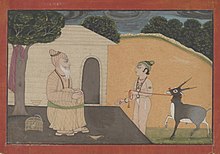
The Upanishads (/ʊˈpʌnɪʃədz/; Sanskrit: उपनिषद्, IAST: Upaniṣad, pronounced [ˈʊpɐnɪʂɐd]) are late Vedic and post-Vedic Sanskrit texts that "document the transition from the archaic ritualism of the Veda into new religious ideas and institutions" and the emergence of the central religious concepts of Hinduism. They are the most recent addition to the Vedas, the oldest scriptures of Hinduism, and deal with meditation, philosophy, consciousness, and ontological knowledge. Earlier parts of the Vedas dealt with mantras, benedictions, rituals, ceremonies, and sacrifices.
While among the most important literature in the history of Indian religions and culture, the Upanishads document a wide variety of "rites, incantations, and esoteric knowledge" departing from Vedic ritualism and interpreted in various ways in the later commentarial traditions. The Upanishads are widely known, and their diverse ideas, interpreted in various ways, informed later traditions of Hinduism. The central concern of all Upanishads is to discover the relations between ritual, cosmic realities (including gods), and the human body/person, postulating Ātman and Brahman as the "summit of the hierarchically arranged and interconnected universe", but various ideas about the relation between Atman and Brahman can be found. (Full article...) -
Image 16Hum Aapke Hain Koun..! (HAHK, transl. Who am I to you?) is a 1994 Indian Hindi-language musical romantic drama film written and directed by Sooraj Barjatya and produced by Rajshri Productions. The film stars Madhuri Dixit and Salman Khan and celebrates Indian wedding traditions by means of a story of a married couple and the relationship between their families; a story about sacrificing one's love for one's family. The basic plot is based on the studio's earlier film Nadiya Ke Paar (1982), which was based on Keshav Prasad Mishra's Hindi novel Kohbar Ki Shart. The film features music by Raamlaxman who also composed a 14-song soundtrack, an unusually large number of songs for that period.
Hum Aapke Hain Koun..! was released on 5 August 1994, and became the highest-grossing film of the year, having grossed between ₹111.63 and ₹128 crore worldwide. It also became the highest-grossing Indian film at the time of its release. It contributed to a change in the Indian film industry, with new methods of distribution and a turn towards less violent stories. It was the first film to gross over ₹100 crore in India, and when adjusted for inflation, is the highest-grossing Indian film of the 1990s and also one of the highest-earning Bollywood films ever. Box Office India described it as "the biggest blockbuster of the modern era." The film was also dubbed into Telugu as Premalayam and was a major success, running for over 200 days in theaters. (Full article...) -
Image 17Munir Hussain (29 November 1929 – 29 July 2013) was a cricket commentator, administrator, and journalist from Pakistan who also played a first-class cricket match for Kalat in the 1969–70 season. He was the first to introduce Urdu commentary to cricket, and was the founder of the first Urdu cricket magazine, Akhbar-e-Watan. During the 1970s, Hussain commentated on the game for Pakistan Television (PTV) and Radio Pakistan, and wrote weekly columns on cricket for the Daily Jang for many years. He received many accolades for his work for cricket. ESPNcricinfo writer Saad Shafqat described him as "a pioneering commentator, groundbreaking publisher, Karachi City Cricket Association (KCCA) mandarin, and sagacious elder presence in the nation's cricket circles". He also served as the president of the KCCA. (Full article...)
-
Image 18Manjappada (transl. Yellow Army; Malayalam: [mɐɲːɐpːɐɖɐ] ⓘ) are an organised supporters' group of the Kochi-based professional football club Kerala Blasters FC, which competes in Indian Super League, the top-tier league of Indian football. One of the largest and most active sports fan groups in the country, Manjappada received the Indian Sports Honours Fan Club of the Year award three times, in 2017, 2019 and 2024.
Founded in 2014 as a Facebook page, Manjappada later expanded and have branches in each of Kerala's 14 districts and in 12 other Indian states; Keralites in 64 other countries are also part of the group. Manjappada is also known for having one of the largest groups of travelling fans in the country, and their presence in the stadium is often called a yellow sea as they wear as much yellow as possible during the matches of the Blasters. In the 2022–23 Indian Super League season, they displayed a 11752 sq ft tifo, which is now far the second largest tifo displayed during a football match in Asia. (Full article...) -
Image 19
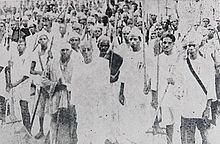
C. Rajagopalachari leading the march along with the volunteers.
The Vedaranyam March (also called the Vedaranyam Satyagraha) was a framework of the nonviolent civil disobedience movement in British India. Modeled on the lines of Dandi March, which was led by Mahatma Gandhi on the western coast of India the month before, it was organised to protest the salt tax imposed by the British Raj in the colonial India.
C. Rajagopalachari, a close associate of Gandhi, led the march which had close to 150 volunteers, most of whom belonged to the Indian National Congress. It began at Trichinopoly (now Tiruchirappalli) on 13 April 1930 and proceeded for about 150 mi (240 km) towards the east before culminating at Vedaranyam, a small coastal town in the then Tanjore District. By collecting salt directly from the sea the marchers broke the salt law. As a part of the march, Rajagopalachari created awareness among the people by highlighting the importance of Khadi as well as social issues like caste discrimination. The campaign came to an end on 28 April 1930 when the participants were arrested by the colonial police force. Its leader Rajagopalachari was imprisoned for six months. The march along with the ones at Dandi and Dharasana drew worldwide attention to the Indian independence movement. (Full article...) -
Image 20
Mangalore (/ˈmæŋɡəlɔːr, ˌmæŋɡəˈlɔːr/ MANG-gə-lor, -LOR), officially known as Mangaluru (Kannada: [mɐŋɡɐɭuːru]), is a major industrial port city in the Indian state of Karnataka and on the west coast of India. It is located between the Laccadive Sea and the Western Ghats about 352 km (219 mi) west of Bangalore, the state capital, 14 km north of Karnataka–Kerala border and 297 km south of Goa. Mangalore is the state's only city to have all four modes of transport—air, road, rail and sea. The population of the urban agglomeration was 619,664 according to the 2011[update] national census of India. It is known for being one of the locations of the Indian strategic petroleum reserves.
The city developed as a port in the Laccadive Sea during ancient times, and after Independence a new port was constructed in 1968 and has since become a major port of India that handles 75 percent of India's coffee and cashew exports. It is also the country's seventh largest container port. Mangalore has been ruled by several major powers, including the Mauryan empire, Kadambas, Alupas, Vijayanagar Empire, and Keladi Nayaks. The city was a source of contention between the British and the Kingdom of Mysore rulers Hyder Ali and Tipu Sultan, and was eventually annexed by the British in 1799. Mangalore remained part of the Madras Presidency until India's independence in 1947 and was unified with Mysore State (now called Karnataka) in 1956. (Full article...) -
Image 21

InterGlobe Aviation Limited (d/b/a IndiGo), is an Indian low-cost airline headquartered in Gurgaon, Haryana, India. It is the largest airline in India by passengers carried and fleet size, with a 63.6% domestic market share as of November 2024. It is the largest individual Asian airline, and one of the largest in the world in terms of passengers carried, with more than 100 million passengers carried in 2023. As of January 2025[update], IndiGo operates over 2,200 daily flights to 123 destinations – 89 domestic and 34 international. It operates cargo services under its subsidiary, IndiGo CarGo. It has its primary hub at Indira Gandhi International Airport, Delhi.
The airline was founded as a private company by Rahul Bhatia of InterGlobe Enterprises Pvt. Ltd., an Indian multinational conglomerate based in Gurugram, and Rakesh Gangwal in 2005. It took delivery of its first aircraft in July 2006 and commenced operations a month later, on 4 August 2006. The airline became the largest Indian carrier by passenger market share in December 2012. The company went public in October 2015. The airline was ranked as the 15th most punctual airline globally in 2022 by OAG. It is also the 6th busiest airline in the world, as per data from RadarBox. (Full article...) -
Image 22Aga Khan III, facilitator of the Simla Deputation
The Simla Deputation was a gathering of 35 prominent Indian Muslim leaders led by the Aga Khan III at the Viceregal Lodge in Simla in October 1906. The deputation aimed to convince Lord Minto, the viceroy of India, to grant Muslims greater representation in politics.
The deputation took advantage of the liberal values of the newly-appointed Minto and his Secretary of State, John Morley, following the election of the Liberals in the 1906 United Kingdom general election, as well as the willingness of the British and the Indian Muslims to cooperate – the British wanted to use Indian Muslims as a bulwark against the Indian National Congress and Hindu nationalism, while the Muslims, based in Aligarh Muslim University, wanted to use the opportunity to secure more political representation for themselves. (Full article...) -
Image 23Sivaji: The Boss is a 2007 Indian Tamil-language vigilante action film co-written and directed by S. Shankar and produced by AVM Productions. The film stars Rajinikanth in the main lead role alongside Shriya Saran, Vivek and Suman. In the film, a software systems architect returns to India from US to provide free medical treatment and education, but has to face hurdles from the system and an influential political leader.
A. R. Rahman composed the music in his 100th milestone composition, while the art direction, cinematography and editing were handled by Thota Tharani, K. V. Anand and Anthony respectively. With a budget of ₹600 million (US$6.9 million), the film was the most expensive Indian film at the time of its release. Rajinikanth became the highest-paid Indian actor with this film, earning a fees of around ₹260 million (US$3.0 million). Principal photography of the film commenced in November 2005 and lasted till February 2007. Filming took place in various locations across Hyderabad, Spain, Italy, New York City, Pune and Chennai. It became the first Indian film to use Dolby Atmos surround sound technology. (Full article...) -
Image 24Khan at a promotional event for Matru Ki Bijlee Ka Mandola in 2013
Imran Khan (Hindustani pronunciation: [ɪmˈɾaːn ˈxaːn]; born 13 January 1983) is an American actor known for his work in Hindi films. He is the nephew of actor Aamir Khan and director-producer Mansoor Khan, and the grandson of director-producer Nasir Hussain. He appeared as a child artist in the films Qayamat Se Qayamat Tak (1988) and Jo Jeeta Wohi Sikandar (1992).
Khan made his adult acting debut in 2008 with the romantic comedy Jaane Tu... Ya Jaane Na, which was a critical and commercial success. His performance in the film won him the Filmfare Award for Best Male Debut. After the failure of his next two films, Khan was initially written off by the media, calling him a "one-film wonder". He then starred in a number of commercially successful comedies such as I Hate Luv Storys (2010), Mere Brother Ki Dulhan (2011) and Ek Main Aur Ekk Tu (2012), and the black comedy thriller Delhi Belly (2011). This was followed by a series of box-office flops and a hiatus. (Full article...) -
Image 25
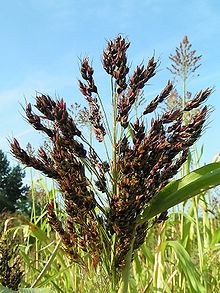
Sorghum bicolor, commonly called sorghum (/ˈsɔːrɡəm/) and also known as great millet, broomcorn, guinea corn, durra, imphee, jowar, or milo, is a species in the grass genus Sorghum cultivated for its grain. The grain is used as food by humans, while the plant is used for animal feed and ethanol production. Sorghum originated in Africa, and is now cultivated widely in tropical and subtropical regions.
Sorghum is the world's fifth-most important cereal crop after rice, wheat, maize, and barley. Sorghum is typically an annual, but some cultivars are perennial. It grows in clumps that may reach over 4 metres (13 ft) high. The grain is small, 2 to 4 millimetres (0.08 to 0.2 in) in diameter. Sweet sorghums are cultivars primarily grown for forage, syrup production, and ethanol. They are taller than those grown for grain. (Full article...)
News
- 7 February 2025 –
- German Federal Police detains 16 Indian nationals found in a van in Aachen, North Rhine-Westphalia, including 15 passengers and the driver, as they attempt to enter the country without valid documents. (DW)
- 29 January 2025 – 2025 Prayag Kumbh Mela
- At least 30 people are killed in a crowd crush at a Hindu festival in Prayagraj, Uttar Pradesh, India. (BBC News)
- 29 January 2025 – 2025 Light Air Services Beechcraft 1900 crash
- A Beechcraft 1900D carrying employees of an oil company crashes in Unity, South Sudan, killing 20 of the 21 people onboard, including one Indian and two Chinese nationals. (CNN) (Reuters)
- 27 January 2025 – China–India relations
- Following the meeting between Indian Foreign Secretary Vikram Misri and Chinese Foreign Minister Wang Yi in Beijing, China and India agree to resume direct air travel between the two countries after a five-year hiatus. (CNA).
- 22 January 2025 – 2025 Jalgaon train accident
- At least thirteen people are killed in a railway accident in Jalgaon, Maharashtra, India. The victims had initially fled from their train following an alleged fire alarm and were subsequently struck and killed by a passing train on the adjacent tracks. (BBC)
Did you know...
- ... that the first known texts written by Brazilian indigenous people, written in 1645, were only completely translated in 2021?
- ... that Frederic Growse's book Bulandshahr: Or, Sketches of an Indian District annoyed the British Indian government so much that they allowed only one edition?
- ... that Self-Portrait as a Tahitian depicts Indian artist Amrita Sher-Gil standing in the shadow of an unknown man?
- ... that Abdul Ghani Azhari wrote Qadim Tarikh-e-Gujjar in Urdu, detailing the ancient history of Gujjars in India?
- ... that Casanova's friend Edoardo Tiretta built a bazaar in India?
- ... that the 2022 Yangtse clash saw Chinese and Indian troops fight hand-to-hand with melee weapons on a high-elevation ridgeline that formed their frontier in the area?
Topics related to India
Timeline of Indian history, Indus Valley Civilisation, Dholavira, Science and technology in ancient India, Meluhha, Aryan invasion theory, Out of India theory, Greek conquests in India, Indian maritime history, Maurya Empire, Ashoka, Shunga Empire, Hoysala Empire, Vijayanagara, Satavahana dynasty, Indo-Greek Kingdom, Indo-Scythians, Indo-Parthian Kingdom, Kushan Empire, Western Satraps, Gupta Empire, Chola dynasty, Pala Empire, Islamic incursions in India, Mughal Empire, Maratha Empire, British Raj, East India Company, Governor-General, Viceroy, War of Independence, 1857, Indian independence movement, Indian National Army, Azad Hind, Quit India Movement, Partition of India, History of Republic of India, Non-Aligned Movement, Sino-Indian War, Indo-Pakistani War of 1947–1948, Indo-Pakistani War of 1965, Indo-Pakistani War of 1971, Kargil War, 2001–02 India–Pakistan standoff, Military, Demographic
Law, Hindu law, Constitution, Political parties (Indian National Congress, Bharatiya Janata Party), Foreign relations, Elections, Political divisions, Reservation in India
Government agencies, Legislative branch (Lok Sabha, Rajya Sabha) Executive branch (President & Vice President, Prime Minister & Deputy Prime Minister, Cabinet Ministers, Cabinet Secretary, Election Commission, Foreign Minister; Law enforcement: CBI, CID, Intelligence: IB, RAW), Directorate General of Income Tax Investigation Judicial branch (Supreme Court), Armed Forces (Army, Navy, Air Force, Border Security Force, Coast Guard)
Himalayas, Western Ghats, Eastern Ghats, Indo-Gangetic Plain, Deccan Plateau, Thar Desert, Ganges, Rann of Kutch, Brahmaputra River, Northeast India; Mountains, Valleys, Islands, Rivers; States and union territories, Cities, Districts, Regions, Fauna, Flora
Rupee, Bombay Stock Exchange, National Stock Exchange, Standard of living, Companies, Reserve Bank of India, Energy policy (Solar, Wind, Nuclear), Tourism, Transport (Expressways, Rail transport, Auto rickshaw),
Languages, Standard of living, Religion
Music (Carnatic, Hindustani, Indi-pop), Dance, Languages, Literature, Architecture, Film & TV, Cuisine, Holidays, Folklore, Education, Media, Indian martial arts
Indian Council of Agricultural Research (ICAR), Indian Institute of Astrophysics, National Centre for Software Technology, AIIMS, IISc, IIT, NIT, BITS-Pilani, INRegistry, Indian numbering system, Indian Space Research Organisation, National Internet Exchange of India, ICRISAT, International Institute of Information Technology, Hyderabad
Indian English, Indian nationality law, Numbering system, Indian Space Research Organisation, Telecommunications, National Highways Development Project, Flag, Vehicle registration plates, Indian nationalism, Metrication in India
Categories
Related portals
Religions in India
Indian Subcontinent
Other countries
Wikipedias in Indian languages
- অসমীয়া (Assamese)
- বাংলা (Bengali)
- भोजपुरी (Bhojpuri)
- বিষ্ণুপ্রিয়া মণিপুরী (Bishnupriya Manipuri)
- गोंयची कोंकणी / Gõychi Konknni (Konkani)
- ગુજરાતી (Gujarati)
- हिन्दी (Hindi)
- ಕನ್ನಡ (Kannada)
- कॉशुर/كشميري (Kashmiri)
- मैथिली (Maithili)
- മലയാളം (Malayalam)
- मराठी (Marathi)
- नेपाली (Nepali)
- नेपाल भाषा
- (Newari)
- ଓଡ଼ିଆ (Odiya)
- ਪੰਜਾਬੀ (Punjabi)
- पालि (Pali)
- संस्कृत (Sanskrit)
- ᱥᱟᱱᱛᱟᱲᱤ (Santali)
- سنڌي (Sindhi)
- தமிழ் (Tamil)
- తెలుగు (Telugu)
- ತುಳು (Tulu)
- اردو (Urdu)
Associated Wikimedia
The following Wikimedia Foundation sister projects provide more on this subject:
-
Commons
Free media repository -
Wikibooks
Free textbooks and manuals -
Wikidata
Free knowledge base -
Wikinews
Free-content news -
Wikiquote
Collection of quotations -
Wikisource
Free-content library -
Wikiversity
Free learning tools -
Wikivoyage
Free travel guide -
Wiktionary
Dictionary and thesaurus
- Pages using the Phonos extension
- Pages with Hindustani IPA
- Pages including recorded pronunciations
- Pages with Hindi IPA
- Pages with non-numeric formatnum arguments
- Pages with Sanskrit IPA
- Pages with Malayalam IPA
- Pages with Kannada IPA
- Portals with triaged subpages from June 2018
- All portals with triaged subpages
- Portals with no named maintainer
- Automated article-slideshow portals with 51–100 articles in article list
- Automated article-slideshow portals with 101–200 articles in article list
- Automated article-slideshow portals with 501–1000 articles in article list
- Wikipedia move-protected portals
- Redirect targets of redirected portals with existing subpages





